Physical Address
304 North Cardinal St.
Dorchester Center, MA 02124
The medial arch of the foot consists of a complex of fascia, ligaments, bone, and tendons that create a tough yet elastic structure that helps provide shock absorption and allow for a dynamic character of the foot to aid in standing, walking, running, and jumping. Pes planus refers to a loss of this medial arch of the foot while standing. This can be a normal anatomic variant occurring in ∼17% to 34% of the population where the function of the arch is able to be recreated during gait, or for which there is no pain or dysfunction present. It can, however, be the result of degenerative forces or injury that lead deformity, loss of function, and subsequent pain. It is about this progressive collapsing foot deformity (PCFD) that the rest of this chapter is dedicated.
Very few conditions in the realm of foot and ankle surgery incite as much controversy as management of the PCFD. Even the name of the deformity and condition has changed many times over the years, as understanding of the pathophysiology and treatment have changed. Like many areas of medicine, this condition has had many academic camps holding to their own views on the pathophysiology and best treatment paths for this condition. Through these various researchers, clinicians, and academic camps, an evolving knowledge about the complex pathophysiology and treatment of this disease can be better understood. In 2019, a group of nine clinician researchers with extensive publications surrounding this condition met to attempt to do just that in providing consensus statements from across academic camps to better address this complex problem. Their proposed name change of this disease state to PCFD from posterior tibial tendon (PTT) dysfunction, or adult acquired flatfoot deformity, attempts to acknowledge the multifactorial nature of this disease and the unique pathophysiology that can be present in a particular patient. The following chapter will attempt to use their findings and statements combined with the evolved thoughts, as well as the commonly accepted PTT dysfunction theories as a framework for better understanding and treating patients with this disease.
With this approach, each patient can be evaluated individually for the specific pathologic components in PCFD that cause pain and disability. The clinician can then address these specific components from the proven, best methodologies created thus far and presented in the literature to provide specific, individualized care to their patients.
The history of study of PCFD has largely centered around the tibialis posterior tendon, as its insufficiency or dysfunction is very often at the center of this disease state. The roots of PTT insufficiency are found in early writings on tenosynovitis. In 1818, Velpeau described the first case of noninfectious tenosynovitis in the hand. In 1895, de Quervain described stenosis-related tendovaginitis in the first compartment of the dorsal carpal ligament of the wrist in more than 900 patients. Kulowski, in 1936, was the first to publish tenosynovitis of the sheath of the PTT, documenting one case. More than a decade later, the first large series of PTT tenosynovitis was published by Lipscomb at the Mayo clinic. Lapidus and Seidenstein commented on two cases of PTT tenosynovitis in 1950, stating “nonspecific chronic tenosynovitis must be considered a rarity, particularly at the ankle.” These early published reports underestimate its prevalence.
In 1955, A.W. Fowler reported on seven cases of PTT tenosynovitis. He found “the condition was seldom diagnosed early, and it was often mistaken for osteoarthritis of the ankle and treated conservatively without relief. At operation, the tendon sheath was swollen and thickened and the tendon greatly enlarged. The inflamed synovium was excised, with relief in all cases.” Although anecdotal, this was the first documented series in which tenosynovectomy was used and found to be successful. This concept was reinforced by Langenskiöld, who, in 1967, documented six cases of PTT tenosynovitis treated surgically after failure of conservative management. These patients experienced great pain relief after debridement of the proliferative granulation tissue.
Key, in 1953, documented the first case of PTT rupture (partial). In the prelude, he states that the case should be of interest, showing great foresight. This worker's compensation case documented the classic signs and symptoms of the condition, including the not-so-unusual missed early diagnosis. This partial rupture was treated with excision of the torn component and debridement of the residual thickened tendon, leaving the patient with 15% disability at the ankle.
Griffiths, in 1965, recognized the difficulty in correcting deformity after late reconstruction of PTT rupture, but all of his “spontaneous” ruptures were in patients with rheumatoid arthritis. Thus confounding factors obviate the direct correlation between PTT rupture and deformity correction. Sixteen years after Key's article, Kettelkamp and Alexander explored spontaneous PTT rupture in four patients without systemic disease. Missed in this article was the prevalence of spontaneous rupture because the authors begin by stating that this mechanism is a rarity. However, the authors pinpoint the challenge of correcting deformity created by delay in treatment. Three of the four patients were treated operatively without correction of tendon length (the retracted tendon was bridged with extensor digitorum longus tendon graft or filled with a Z-plasty lengthening), leaving the patients with residual pain and no correction of deformity. Results at best were rated fair.
In 1974, Goldner described the relationship of midfoot ligaments to progressive talipes equinovalgus in traumatic and degenerative conditions of the PTT. This article studied nine patients with either of these etiologies, all resulting in the common pathway of an acquired flatfoot deformity. The authors correctly recognized a disorder of the medial plantar calcaneonavicular ligament resulting in limited support through elongation resulting from repetitive stress. Surgical intervention was done for deformity correction as well as pain relief. Transfer of the flexor hallucis longus (FHL) to substitute for the deficient or absent PTT was done in all cases. The tendon was sutured to the periosteum under the navicular. This tendon was chosen over the flexor digitorum longus (FDL) because of its “more tendinous” structure, larger muscle mass, and the potential ability to elevate the sustentaculum tali to combat hindfoot valgus. In addition, the medial plantar calcaneonavicular ligament was plicated, after experience in not doing so resulted in persistent or progressive deformity. The authors also found failure in simply advancing or plicating the PTT. They also believed that a contracted gastrocnemius–soleus complex contributes to the deformity and must be addressed at the time of surgery.
Eight years later, in 1982, the concept of spontaneous rupture of the PTT resurfaced with a scientific presentation by Mann and Specht. The authors reviewed eight patients undergoing a variation on Goldner's FHL tendon transfer by using the FDL tendon as the source replacement tendon. Rationale for avoiding the use of the FHL tendon for transfer centered on the importance of maintaining full flexion strength in the hallux in compromised patients.
More recent work focuses on the bony, ligamentous, and articular components, as well as their interaction and contributions to deformity within the disease, as they relate to tibialis posterior tendon dysfunction. Particular focus has been in evaluating the ligaments of the medial column, notably the spring ligament and deltoid ligament, in maintaining the relationship along the talonavicular and tibiotalar joints. Johnson and Strom first described the relationship of instability at the talonavicular joint in their study in 1989, evaluating how the navicular and calcaneus move around a fixed talus. This was then further revised by Toolan et al in 1999, who defined the idea of peritalar subluxation for evaluation of the relationships of these joints in PCFD. The importance of the spring ligament complex in maintaining these relationships has been elucidated and continues to evolve thanks to contributions from Gadzag, Deland, and many others. In addition, further work has demonstrated the importance of the naviculocuneiform ligament and midfoot joint complex in helping to maintain the arch, further demonstrating the complex nature of the deformity.
The focus on these ligaments and the relationships of the joints involved, in addition to the posterior tibialis tendon and its central role in this disease, has allowed for an evolving understanding of the pathophysiology and more nuanced treatment options. Many researchers, clinicians, and patients can be thanked for their contribution to our current understanding; their contributions are summarized in the following chapter.
The posterior tibialis muscle arises from the interosseous membrane and adjacent surfaces of the tibia and fibula in the proximal one third of the leg. The myotendinous junction appears in the distal one third of the leg. The PTT courses directly behind the medial malleolus at a relatively acute angle. The groove is shallow, and the flexor retinaculum binds the tendon tightly into this groove. Thus, the tendon passes posterior to the axis of the tibiotalar joint and medial to the axis of the subtalar joint, making it an ankle plantar flexor and hindfoot invertor. In fact, the PTT is located farther medially from the axis of the subtalar joint than any other tendon about the ankle, and it therefore has the greatest degree of leverage to bring about inversion of the subtalar joint. It then passes beneath the calcaneonavicular ligament to insert into the tuberosity of the navicular. It is unique in that it has 11 insertion domains: the navicular; the sustentaculum tali; the medial, middle, and lateral cuneiforms; the cuboid; and the bases of the second, third, and fourth metatarsals. By its insertion into the midfoot, the tibialis posterior both adducts and supinates the forefoot.
Tendons possessing synovial sheaths have altered directional courses or are bound by tunnels or retinacula, and they are generally located at the distal portions of the upper and lower extremities. Linear tendons (e.g., the Achilles tendon) often do not have sheaths. The mean length of the PTT sheath is 71 mm in men and 66 mm in women. The tendon sheath runs approximately 45mm proximal to the apex of the medial malleolus and continues approximately 26 mm distal to the peak of the malleolus. The excursion of the PTT is only 2 cm.
The sheaths act to decrease the frictional forces encountered during tendon motion. The sheath consists of three layers: a parietal layer lining the deep fibrous surface or fibroosseous canal, a visceral layer covering the tendon, and a mesotenon connecting the visceral and parietal layers serving as one source of the tendon's blood supply. As gliding occurs, the visceral layer glides against the parietal layer. The PTT is unique in that it does not contain a complete mesotenon and must receive its vascular supply through other channels.
The PTT receives its blood supply from four regions: the vessels proximal to the muscle insertion, the connective tissue peritendinous arterial network, the arteries running to the tendon in the triangular vincula, and vessels from the periosteal insertion of the tendon. Frey et al found that the tendon receives its blood supply at the musculotendinous junction via the posterior tibial artery. They noted that a mesotenon was present in the PTT proximally, providing an additional network of vascular channels from the posterior tibial artery. The visceral layer also provides additional proximal blood supply, using this mesotenon as a conduit. This visceral layer remains closely adherent to the epitenon proximally. Distally, at the tendon–bone interface, the periosteal vessels provide the tendon's blood supply. These periosteal vessels are terminal segments for the medial plantar branch of the posterior tibial artery, supplemented two thirds of the time by the medial tarsal artery, a branch of the dorsalis pedis artery.
The PTT functions to stabilize the hindfoot against valgus forces or eversion. The tibialis posterior is a stance phase muscle, firing from heel strike to shortly after heel lift-off. It decelerates subtalar joint pronation after heel contact through eccentric contraction. At midstance, it stabilizes the midtarsal joints. During the propulsive phase of stance, the tibialis posterior adducts the transverse tarsal joint, initiating inversion of the subtalar joint. This action has two beneficial effects on the gastrocnemius–soleus complex: it locks the transverse tarsal joint, allowing the gastrocnemius-soleus complex to maximize the plantar-flexion force during gait, and it shifts the direction of pull of the Achilles tendon further medially, allowing the gastrocnemius-soleus complex to become the primary invertor of the subtalar joint through increased leverage. In doing so, the foot can become a rigid lever that supports the propulsive phase of gait (see Chapter 1 ).
Quantifying this action with respect to gait, during the normal walking cycle, eversion occurs in the subtalar joint at the time of initial ground contact. The tibialis posterior becomes functional at about 7% of the cycle, the soleus muscle at about 10% of the cycle, and the lateral head of the gastrocnemius muscle at about 25% of the gait cycle. Dynamic electromyography suggests that this initial eccentric contraction of the posterior tibial muscle lasts from 7% to 30% of the gait cycle during stance. After this, progressive inversion occurs, starting at approximately 30% of the cycle through concentric contraction of the tibialis posterior. The tibialis posterior muscle is silent during swing phase, where its antagonists enjoy maximal benefit. The primary antagonist of the posterior tibial muscle is the peroneus brevis muscle, functioning to abduct the midfoot and evert the hindfoot. Cross-sectional area studies note that the peroneus brevis muscle is 41% as strong as the posterior tibial muscle (relative strength of the PTT is 6.4, and of the peroneus brevis, 2.6). Physiologically, this is manifested through the primary function of the peroneus brevis in unlocking the transverse tarsal joints and everting the hindfoot during the non–weight-bearing swing phase of gait.
Stabilization of the longitudinal arch by the PTT remains a topic of debate. Most authors agree, however, that there are both static and dynamic forces at work. Static support theories fall into two camps, namely that the foot acts as a truss or that the foot acts as a beam. The truss theory is supported by Lapidus. A truss works by creating two struts that meet at an apex, supported at the base by a tie rod, thus forming a triangle. As the apex is loaded, compressive forces are applied to the struts, and tensile forces are applied to the tie rod. As long as the tie rod remains intact, the struts do not collapse, and the truss holds firm. Relating this model to the anatomy of the foot, the tie rods are represented by the plantar aponeurosis. Hicks believes that this model becomes critical at toe-off, when the windlass mechanism has maximal effect on tightening the plantar fascia.
The beam theory, proposed by Sarrafian, supports a less rigid construct. In this model, the foot is a curved beam that sags when it is loaded. Forces generated at the midportion of the beam are compressive on the convex side of the beam and tensile on the concave side. The curved portion of the beam consists of the bones of the midtarsus. Thus, tension directly affects the structures on the concave side of these bones, namely the plantar ligaments. Anatomically, these ligaments consist of the long and short plantar ligaments, the calcaneonavicular (spring) ligament, and the bifurcate ligament that are all attachment sites for the PTT. It also includes the naviculocuneiform ligament distal to the tibialis posterior attachment.
The spring ligament originates from the sustentaculum tali of the calcaneus and inserts on the navicular. It consists of two distinct bands: a stronger superior medial calcaneonavicular ligament and the inferior calcaneonavicular ligament just lateral to it. The latter structure has a medial plantar oblique and the plantar inferior band. The bifurcate ligament is a y-shaped ligament that spans the calcaneocuboid joint and attaches onto the navicular and dorsomedial aspect of the cuboid. It is located on the dorsal surface of the calcaneocuboid joint and has a main proximal stem that attaches to the calcaneal sulcus. It then divides distally to attach to the navicular and dorsomedial aspect of the cuboid, which helps to stabilize the calcaneocuboid joint, the talocalcaneonavicular joint, and midtarsal joints. The naviculocuneiform ligaments function to stabilize the naviculocuneiform joints. Classically these were described by Seraffian as three separate plantar ligaments. Recent work by Swanton at al has called this into question. They found extension of the tibialis posterior tendon complex medially onto the navicular, thus representing a combined tendoligmentous complex.
Dynamic support of the arch revolves around the tibialis posterior muscle and the intrinsic musculature of the foot. Support of the arch by the intrinsics is discussed in the next section. With respect to the posterior tibialis muscle's contribution, Kapandji suggests that contraction of the tibialis posterior adducts and plantar flexes the navicular on the talar head. In doing so, it buttresses the medial longitudinal arch against collapse. In addition, the ligamentous attachments of the PTT have an effect by pulling the cuboid medially along with the navicular through the bifurcate ligament. The cuboid then pulls the calcaneus medially through the strong calcaneocuboid ligament, providing additional support to the talar head through the anterior and middle facets.
The PTT has a limited excursion of only 2 cm. Thus, any insult, no matter how minor, that lengthens this tendon has an adverse effect on its function. This lengthening may be gradual or acute, depending on the underlying pathologic process. The inversion power provided by the PTT has been underestimated by some, the thought process being that all the posterior compartment muscles act to provide this function. Jahss noted that the normal inversion power of all posterior calf muscles combined is 12 to 15 pounds of torque. Patients with PTT rupture undergo a substantial reduction in this force, lowering the torque to 3 to 6 pounds, thus emphasizing the importance of this tendon.
In acute loss of PTT function, the integrity of the longitudinal arch may be initially maintained through static restraints. The valgus deformity of the hindfoot created by unopposed pull of the peroneus brevis leads to secondary attenuation of these static restraints. According to Duchene, this allows the gastrocnemius-soleus complex to act with a downward force at the talonavicular joint. Downward and medial pressure of the talar head stretches the calcaneonavicular ligaments. The plantar ligaments placed medially that unite the tarsus and metatarsus are comparatively much weaker than those on the lateral side. Eventually, the passive structures of the longitudinal arch give way under continued dynamic insult, and a flatfoot deformity results. In the beam theory, the natural curved beam of the bony architecture of the foot becomes straightened by repetitive tensile forces on its concave surface. In particular, the spring ligament is at risk of failure.
This view is supported by Niki and Sangeorzan who examined the progression to flatfoot deformity in a biomechanical study. The authors evaluated the sequential cause of the acquired flatfoot by creating a custom acrylic foot-loading frame to simulate heel strike, stance, and heel rise by altering tendon tension through regulated pneumatic cylinders. Simultaneously, axial compressive loads were applied to the tibias of these cadaveric specimens. Absence of posterior tibialis function was simulated simply by not activating the pneumatic cylinder attached to this tendon, while continuing normal cylinder load on all other tendons crossing the ankle. Thus, through cyclic evaluation, the authors studied the foot architecture with all tendons loaded in the absence of the PTT and, finally, with activation of the PTT (simulating repair). Small but statistically significant changes in the angular orientation of the bone architecture of the foot were noted after release of the PTT. These changes were not of the magnitude seen in a true flatfoot. This led the authors to surmise that the intact osteoligamentous structure of the foot is at least initially able to maintain normal alignment after acute PTT dysfunction. Of interest, when the PTT was restored in the flatfoot model, it did not restore the angular changes to anatomic magnitude. Again, these data support the importance of progressive longitudinal arch collapse through attenuation of the spring (and other plantar) ligaments that can occur with prolonged insult.
The source of the attenuation may be directly related to a disorder within the gastrocnemius-soleus complex and its mechanical orientation. The valgus deformity of the hindfoot created by dysfunction of the PTT substantially alters the mechanical pull of the Achilles tendon. The Achilles tendon is placed lateral to the axis of the subtalar joint, allowing it to become an evertor of the hindfoot, accelerating the valgus deformity. Equally important, the moment arm of the plantar flexion force becomes the talonavicular joint rather than the metatarsal heads. This proximal alteration in force concentration comes directly from the perpetual valgus hindfoot's unlocking the transverse tarsal joint, eliminating the rigid lever of the foot at toe-off. This action accelerates attrition of the spring ligament with each gait cycle.
The intrinsic musculature attempts to compensate for the deficient arch by increased work. According to Mann and Inman, the intrinsic muscles stabilize the transverse tarsal joint and thus create a more efficient lever. As expected, flatfooted persons require increased muscle action to maintain a rigid lever considering the lack of support at other portions of the arch. Activity of the intrinsic muscles thus begins at an earlier portion of the stance phase of gait, measured at 10% of the cycle rather than the normal 40%.
This cascade of events leads to a common pathway as the PTT fails and a flatfoot develops. Changes in the bone architecture are as those found by Niki, involving plantar flexion of the talus, eversion together with internal rotation of the calcaneus, and eversion of the navicular and the cuboid. Clinically, the hindfoot drifts into valgus and the forefoot into abduction. The posterior tibialis muscle fires earlier and longer to stabilize the hypermobile foot and to control the increased pronation and deviation. This increased demand on the muscle leads to fatigue. The deltoid ligament becomes involved late, as the severe flatfoot deformity places increased demand on the medial soft tissues, creating a valgus deformity and arthritic wear at the tibiotalar joint. Late-term effects occur as the calcaneus falls into further valgus. Abutment against the inferior tip of the fibula creates subfibular impingement. In addition, the relative shortening of the gastrocnemius-soleus complex leads to a permanent contraction, creating a relative equinus deformity of the ankle.
Spontaneous rupture of the PTT was first suggested by Kettelkamp and Alexander in 1969. Before that time, the authors were unable to locate a case of spontaneous rupture of the PTT in the literature. Controversy exists as to whether spontaneous rupture is truly spontaneous. McMaster noted that spontaneous rupture did not occur in rabbits. In fact, even with a 75% iatrogenic laceration of the tendon, no ruptures occurred when normal stresses were applied. He stated that some form of disease process must be present to predispose the tendon to rupture.
Trauma of the magnitude to create a complete rupture of the PTT is rare. Funk et al reported that of 19 patients treated for PTT tenosynovitis, only 4 could recall an inciting event. The authors agreed with McMaster, stating that the lack of proximity of major trauma suggests that rupture of the PTT is more likely related to an intrinsic abnormality or biomechanical failure rather than an extrinsic traumatic factor.
Trauma to the tendon underlying PTT rupture may be age stratified. Myerson noted in a group of elderly patients with rupture of the PTT that only 37 (14%) recalled a specific inciting traumatic event. In contrast, Funk et al noted antecedent trauma in one-half of the younger population in their study. This becomes evident from the case reports in the literature documenting acute rupture of the PTT resulting from ankle fractures. The first such report, by Giblin, appeared in 1980: An interposed distal stump of a ruptured PTT prevented reduction of an isolated medial malleolus fracture. The patient had no prior symptoms of PTT dysfunction. In 1983, De Zwart and Davidson noted that two patients sustained rupture of the PTT at the level of a fractured medial malleolus in bimalleolar ankle fractures. A third report suggested a common theme of a small flake of bone avulsed and visualized radiographically at the medial tibial metaphysis, just proximal to the medial malleolus fracture on oblique views.
Further reports suggest that acute rupture of the PTT is more commonly seen in ankle fractures caused by pronation and external rotation. The tight binding of the PTT by the flexor retinaculum contributes to acute rupture through sudden trauma. Fracture of the medial malleolus is not necessary, because the ruptured and interposed PTT may be seen with a deltoid ligament rupture associated with a pronation–external rotation fracture. This can even be seen in children, raising the index of suspicion to prevent delayed flatfoot from developing after fracture of the ankle. Finally, there is some suggestion in the literature that acute injury to the PTT is the mechanism of disruption in dancers, rather than a slower degenerative process. This article reviewed four dancers with either split tearing or more significant destruction of the PTT of acute onset. Often diagnosed initially with FHL tenosynovitis, the authors found this population did not present with a flatfoot, given their preexisting cavus consistent with high-level ballet dancers. Advanced diagnostic imaging was required to hone the diagnosis, and the pathology found at surgery suggested a more proximal location (directly posterior or superior to the medial malleolus) to the lesion than commonly seen in the more distal insidious ruptures.
More likely, repetitive microtrauma can lead to the indolent progression of symptoms, perhaps through a degenerative or inflammatory response, that ultimately leads to tendon disruption. A tendon will not tolerate more than 1500 to 2000 cycles per hour. Tendon overloading can cause microtears that trigger an inflammatory response. Such microtears fail to heal, exacerbating the inflammatory response. As persons age, the tendon's elastic compliance decreases through changes in the collagen structure, further predisposing the tendon to damage. Myerson's et al group of older patients reported the onset of symptoms at an average age of 60 years, seeking treatment at an average age of 64 years.
Progressive tendon degeneration may disrupt the PTT. Mosier et al evaluated gross and histologic specimens of 15 surgically resected PTTs excised for rupture. Control tendons were those obtained from cadavers with no known disorder to the PTT, confirmed by gross inspection of the tendons at the time of harvest. Direct inspection of the diseased tendons revealed a characteristic increased length from the malleolus to the insertion point when referenced with the cadaver tendons. Loss of normal tendon sheen and color was noted, and the tendon had a dull, white appearance. Incomplete longitudinal splitting was present without transverse rupture. Microscopic specimens stained appropriately revealed increased mucin content and myxoid degeneration. Excess mucin was found to alter the normal linear orientation of the tendon collagen bundles. Myxoid degeneration was consistent with a rupture within the substance of the tendon. At the insertion of the PTT, fibroblastic hypercellularity and chondroid metaplasia were present. Again, this had the effect of disrupting the linear collagen orientation. This haphazard or wavy configuration of the collagen leads to decreased tensile strength within the tendon, potentially leading to “spontaneous” rupture. This, of course, would validate McMaster's concept of predisposition. Most important, the authors found no signs of inflammatory infiltrates within either the tendon or the tenosynovium.
An evaluation of hormonal biochemical influences upon PTT disease was explored by Bridgeman et al. The authors noted the higher propensity of PTT dysfunction in perimenopausal and postmenopausal women, leading to a concern that changes in hormone physiology might be the source of this observation. Evaluating both male and female patients through direct biopsy in those undergoing reconstruction, the authors used the adjacent FDL tendon as a control. Using a centrifuge to isolate tendon ribonucleic acid (RNA), followed by reverse transcription to isolate estrogen receptors in the specimens, the authors noted no difference in receptor expression between male and female patients. In addition, the diseased posterior tibial in female patients expressed a higher estrogen receptor level than the comparative control tendons. However, the sample size was not large enough to draw a statistically significant conclusion. A larger cohort will be required to discern this potential influence upon PTT dysfunction to explain the relative partiality towards female patients.
Trevino, in 1981, performed the first histopathologic examination of diseased PTTs. The authors found a stenosing tenosynovitis characterized by a loose, wavy configuration of the collagen. Other authors confirmed this wavy configuration to the collagen, with irregular spaces between bundles. In fact, all of these investigators found little evidence of inflammation in patients with rupture of the PTT. Also, although no complete transverse ruptures were visualized, incompetence of the tendon in combination with elongation of the tendon was clear. Sutherland suggested, through electromyographic (EMG) studies, that the magnitude of elongation sufficient to reduce the ability of the PTT to act as a dynamic stabilizer of the longitudinal arch was as little as 1 cm. Clearly degenerative changes manifested as intrasubstance collagen disruption is enough to create this length deficit.
Damaged tendon makes an attempt to heal itself, and it does so with this poorer quality collagen. Changes in the composition of the collagen matrix in disrupted PTTs was explored by Goncalves-Neto et al. The authors confirmed the alteration in the normal linear orientation of collagen bundles in involved tendons. They noted neovascularization—an increase in size, number, and branching of blood vessels—in conjunction with an increased number of fibroblasts. These findings suggest attempts at repair. More important, they noted a shift in the type of collagen within the diseased tendon. Normal tendons are composed of type I collagen, with minor amounts of type III, IV, and V collagen. Incompetent PTTs shifted the makeup of this collagen from 95% to approximately 56% type I. In addition, type III collagen increased 54%, and type V increased 26%. Investigators have found that as the percentages of type III and type V collagen increase within the extracellular matrix, the diameter of the collagen fibrils undergoes a marked reduction.
Even normal anatomic PTT exhibits alterations in collagen composition at specific locations. Petersen et al found a change in composition of the superficial zone of the PTT directly adjacent to the pulley of the posterior medial malleolus. Using both light and transmission electron microscopy in combination with immunohistochemical methods, the authors noted increased type II collagen as well as acid glycosaminoglycans consistent with fibrocartilage rather than the standard composition of dense connective tissue. The authors believe the physiologic basis of this shift in composition is related to the character of the PTT's changing from a traction tendon to a gliding tendon (subject to intermittent compressive and shear stresses) as it courses behind the medial malleolus.
The only portion of the PTT that exhibited composition consistent with fibrocartilage is the portion directly adjacent to the pulley, which is consistent with the most common site of spontaneous rupture. The fibrocartilage does not penetrate the entire diameter of the tendon at this location; rather, it remains superficial. This finding is physiologic, rather than pathologic, in the PTT. Thus, it remains a point of weakness irrespective of the underlying disease process, but it remains vulnerable to any disease process affecting the tendon. From such an insult, a poor repair response occurs from the relatively avascular tissue. Repetitive stress or microtrauma can create such an insult because of the suspected lower resistance to tensile forces.
Alternatively, inflammation impacts a subset of patients during the early stages of PTT dysfunction. Jahss first suggested a possible link between seronegative spondyloarthropathies and PTT tenosynovitis in 1982. Seronegative disorders are inflammatory conditions generally occurring outside the synovium. They disproportionately involve sites of attachment of the capsule, ligament, and tendon to bone, known as entheses. These arthropathies are generalized and often involve multiple sites in the upper and lower extremities. Common concurrent connective tissue disorders include inflammatory bowel disease, psoriasis, urethritis, uveitis, conjunctivitis, and oral ulcers. Myerson concluded that the majority of younger patients with PTT disorders have signs of systemic enthesopathies. This patient population was predominantly female. Symptoms of systemic disease occur at an average age of 27 years, and patients seek treatment at an average age of 39 years. Two thirds of the patients had, in addition to PTT tenosynovitis, other areas of inflammatory involvement. More than half had a first-degree relative with evidence of a connective tissue disorder.
Myerson determined that two separate patient populations developed PTT tenosynovitis and subsequent dysfunction. Both populations underwent human leukocyte antigen (HLA) typing, supporting the association between age and seronegative spondyloarthropathies. Although only two patients in the older group had positive HLA markers, a majority of the younger population had HLA markers in their blood. Of particular interest is the Cw6 allele, the primary allele for psoriasis. Nearly half (47%) of the younger patient group had this allele compared with none in the older group. Only 12% in the institutional control group had Cw6 in their blood. This constellation of symptoms and laboratory results strongly suggests that inflammation plays a role in the inciting event of PTT dysfunction, at least in persons afflicted at a younger age. The younger population had a more rapid progression toward PTT rupture, encouraging prompt recognition of this potential cause and allowing earlier intervention. Stratifying the condition on an age-related basis has value only in patients with associated systemic conditions because degenerative tendinopathy has strong supportive evidence not only in Myerson's older category of patients but also in the literature just noted.
In contrast to seronegative diseases that demonstrate an inflammatory cause inciting PTT dysfunction, rheumatoid arthritis has yet to show that it has a direct role in tendon destruction. Chronic inflammatory mediators noted in rheumatoid arthritis are known to cause tenosynovitis. Michelson suggested such a cause exists in as many as 64% of patients afflicted with rheumatoid disease. However, when he narrowed his criteria for diagnosis to include loss of a longitudinal arch, inability to perform a single-limb heel stance, and the inability to palpate the PTT, the incidence dropped to 11%. The problem with all such studies is the concurrent destruction of the ligament complex at the subtalar and talonavicular joints known to occur in rheumatoid disease. That is, any of the signs of PTT rupture noted by Michelson can be seen in patients with joint destruction from the synovitis of rheumatoid disease that creates flatfoot.
Other studies suggest that the PTT is actually overpulling in rheumatoid patients in an attempt to correct hindfoot valgus, rather than undergoing destruction by the underlying disease process. Jahss examined the PTT in rheumatoid patients undergoing arthrodesis of the hindfoot for symptomatic flatfoot and found the tendon normal in appearance. Kirkham and Gibson studied 50 patients with rheumatoid arthritis and noted no instance of PTT dysfunction in those with progressive longitudinal arch collapse and hindfoot valgus. Finally, Keenan performed electromyography on five patients with rheumatoid arthritis and hindfoot valgus and observed that muscle activity actually increased in this patient population versus controls. Thus, attempts at linking the inflammation of rheumatoid arthritis to destruction of the PTT remain in question.
A vascular cause of PTT dysfunction has been suggested by numerous authors. Holmes and Mann performed a review of 67 patients with a diagnosis of PTT rupture. This epidemiologic study found a statistical correlation between tendon rupture and both obesity ( P < 0.05) and hypertension ( P < 0.05). This patient population was older, ranging in age from 51 to 87 years, and the correlation remained strong in spite of the general population prevalence of these conditions in this age category. In addition, diabetes and steroid use (both oral and injection) were linked to PTT dysfunction. All four associated conditions directly or indirectly compromise the blood supply to the PTT. Diabetes promotes vascular hyperplasia and sclerosis, leading to stiffness of the arterioles, luminal narrowing, and blood flow resistance. Steroids lead to local vascular attenuation, creating avascular tissue. Such ischemic insults can compromise an already tenuous blood supply to select portions of the PTT, leading to degenerative tendinopathy. This is supported by Kennedy and Willis, who have shown through tendon-loading studies that steroid injections into the tendon sheath significantly weaken the tendon for up to 2 weeks. They found that the tendon disruption is related to collagen necrosis at the site of injection. Compromise in a tenuous blood supply can also occur in patients who have undergone previous surgery on the medial portion of the foot and ankle.
The PTT receives its blood supply primarily from the posterior tibial artery, although the insertion of the tendon might receive its blood supply from branches of the dorsalis pedis artery. There has been debate as to the significance of its aberrant blood supply contributing to tendon disorder. Frey et al used a modified Spaltholz technique to study the blood supply of the PTT. In doing so, they injected 28 cadaveric limbs with an India ink–gelatin suspension. This mixture was cleared via the Spaltholz technique, destroying the normal histology of the tendon while allowing visualization of the gross external and internal vasculature. To confirm isolated aberration in the PTT blood supply, they examined the adjacent FDL as a control. They discovered an important hypovascular zone (14 mm long) is present approximately 40 mm proximal to the insertion of the PTT. This zone of relative avascularity generally begins at the medial malleolus as the tendon courses out of the groove. Of interest, no mesotenon was present at this level, and the visceral layer of the synovial sheath was hypovascular. In the control FDL tendon, no such zone existed, and consistent vascularity was noted throughout the tendon.
This hypovascular zone has a corollary in the supraspinatus tendon, where Rathbun and Macnab noted that tension in a select portion of the tendon can wring out the blood supply. Without an adequate blood supply, cells require surrounding extracellular fluid to provide nutrition through diffusion. The limits of diffusion are clear, however. Smith suggests that nutrition will not be adequate when travel distance from source to destination exceeds 1 to 2 cm. Frey et al thus reasoned that the hypovascular zone allows PTT deterioration with age.
There have been critics of this theory, however. In 2002, Petersen et al used a different method to assess blood supply to the PTT. They criticize the Spaltholz technique as providing a large number of false-positive and false-negative results because of its subjective nature. Instead, they used a combination injection of 99m Tc, India ink, and gelatin, specifically studying the laminin. According to the authors, laminin is a basic component of the basement membrane, and staining with 99m Tc reliably and objectively detects blood vessels in the dense connective tissues. Macroscopic assessment of the tendon at the level of the medial malleolus revealed an avascular, rather than hypovascular, segment. The majority of the avascular tissue was concentrated directly where the tendon is in contact with the malleolus. Confirmation was achieved through the immunohistochemical findings, which revealed an absence of laminin in this same location. Laminin was noted in the posterior quarter (farthest from the contact zone against the malleolus) of the PTT and proximal and distal to the malleolus.
Vascular theories explaining PTT degeneration and rupture have been challenged by Mosier et al. The disorder of the collagen was discussed earlier. In addition to the increased mucin and myxoid degeneration, the authors noted neovascularization in the degenerative zone of the PTT. They surmised that the tendon cannot be avascular or hypovascular in these zones because the new blood vessels had to arise from existing circulation. In addition, they postulated that the fibroblast hypercellularity that they noted on the microscopic sections indicates increased metabolic activity within the presumed hypovascular zone, which is counterintuitive to the absence of vascular flow.
Two anatomic theories exist in the literature as to why the PTT is especially prone to developing long-standing inflammation and degeneration. The first potential agent is the overlying flexor retinaculum, which Jahss suggests can cause compression and constriction of the tendon through synovial enlargement. This can impede circulation, fueling tendon degeneration. Second, the sharp turn or angle behind the malleolus creates excessive frictional forces with physical activity. The excessive friction can contribute to the indolent inflammatory process.
In line with repetitive mechanical torque creating deficiency in the PTT are theories that congenital pes planus contributes to the disorder. Cozen suggested that greater stress is placed on the PTT because of both the increased subtalar motion and medial column sag seen in patients with flexible flatfoot. This is supported by Dyal et al, who reviewed radiographs of patients with PTT insufficiency and compared them with radiographs on the contralateral (asymptomatic) side. Using angular measurements defined by Bordelon and Sangeorzan et al, the authors noted that 84% of asymptomatic feet and 86% of symptomatic feet had flatfoot deformities. These results were stratified to reveal that 23% of asymptomatic feet and 32% of symptomatic feet were moderately or severely flat. Interobserver reliability was highly correlated ( P = .0001) among three surgeon observers, strengthening their results. Of course, this study does not prove that asymptomatic congenital pes planus is a potential cause of PTT insufficiency, but the suggestion is strong.
Indirectly, the contribution of a congenital flatfoot to PTT dysfunction is supported by Imhauser et al using an in vitro model evaluating PTT function at heel rise. Unlike previous models, this construction allowed rotation of the tibia to contribute to a more physiologic gait pattern simulation. After creating a flatfoot deformity (through ligament sectioning), the authors noted a medial shift in load acting on the foot, placing undue stress on the PTT, and other medial structures, at heel lift. Such repetitive stress has already been discussed as a potential cause in PTT dysfunction.
This latter concept is further supported by a 2006 paper by Uchiyama et al. This study compared the gliding resistance of the PTT within its sheath both in simulated flatfoot and without pathology at different ankle positions. Gliding resistance mimics friction applied to the tendon in both static (standing) and dynamic (walking) situations. The authors extrapolated a validated technique developed to measure gliding resistance of tendons in the hand, which they found highly repeatable. Before flatfoot, the gliding resistance with the ankle in neutral averaged 77 N. After flatfoot deformity, this resistance increased to 104 N, on average. The authors postulated that this increased gliding resistance may accelerate tendon degeneration in both preexisting congenital flatfoot deformity and in progressive adult acquired flatfoot disorders.
Additionally the presence of an accessory navicular has a high correlation with developing PTT dysfunction. This is likely due to the increased potential for inflammation within the tendon that irritation of a mobile accessory navicular can produce within the tibialis posterior tendon at its insertion to the navicular.
It seems obvious that the cause of PTT insufficiency is multifactorial and patient specific. The insufficient tendon will lead to progressive incompetency of the other plantar ligaments where a patient’s existing anatomy can lead to further progression and deformity that will not able to return without intervention. It is important for the clinician to assimilate the information discussed here to arrive at the correct underlying mechanism creating the disorder and assess the individual pathophysiology present, so that proper treatment decisions can be made.
Physical examination of the patient with pes planus begins with the patient standing barefoot, with the lower extremity exposed proximal to the knee. The examiner must ensure that the patient is standing with both knees facing forward because the patient frequently tends to externally rotate the involved extremity. The alignment should be assessed as it may be anatomic and symmetric, or the flatfoot deformity may be pronounced ( Fig. 29-1 ). In this position, swelling or fullness about the medial ankle may be apparent. In some patients, forefoot abduction is obvious, as is impingement of the distal fibula against the calcaneus through hindfoot valgus collapse. The skin may be wrinkled laterally in this subfibular region. Direct palpation to the subfibular region with the ankle and hindfoot loaded elicits pain. In addition, in this position, with the feet symmetrically loaded, the examiner can take one finger and place it underneath the arch until striking soft tissue. By comparison with the opposite extremity in the same location, a rough estimate of arch collapse is noted. It is always important to compare to the asymptomatic side, as existing pes planus likely predisposes to progressive deformity, and understanding the differences from the patient’s “normal” foot can help to further assess the pain generators.
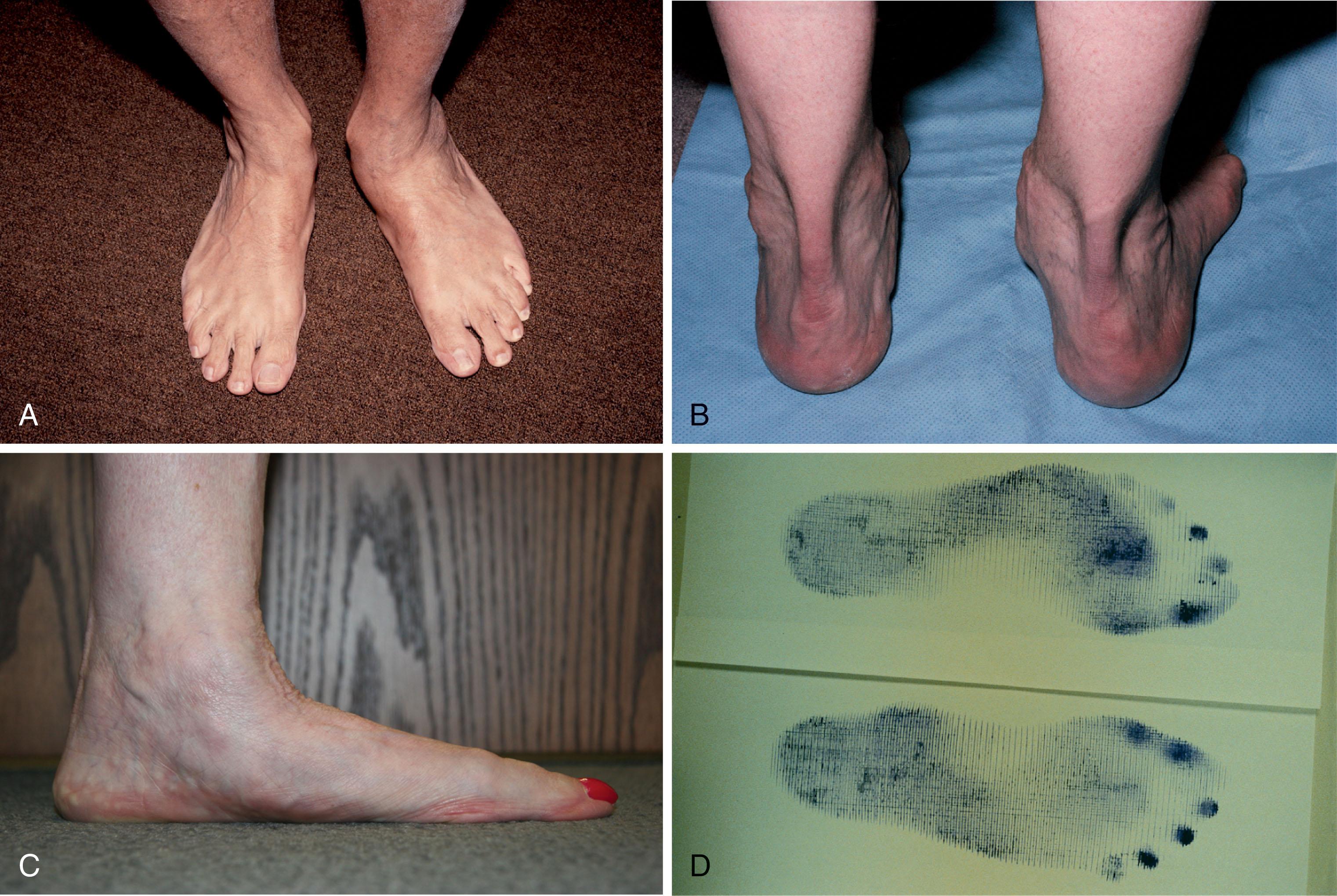
From this position, the patient is asked to externally rotate the involved extremity 90 degrees, maintaining a fully loaded state. Collapse of the talonavicular joint may be appreciated by viewing the foot medially in this position. Calluses plantar to the talar head may be seen, and collapse at the first metatarsal–cuneiform joint may be noted. Rotating the leg 180 degrees to visualize the lateral foot and ankle, the examiner can develop a better appreciation of subfibular impingement. In this position, range of motion of the ankle may be checked and compared with the opposite extremity. It is important to examine ankle range of motion in a loaded state to avoid misrepresentation by compensation from the Chopart joint and forefoot joints. In the most advanced cases, this compensation becomes apparent as the patient passively dorsiflexes beyond neutral and the heel rises off the ground while the midfoot joints collapse.
The patient is next asked to face opposite the examiner, again with the knees symmetrically aligned forward. Hindfoot valgus should be noted and can be roughly estimated by visualizing through a goniometer to the patient's hindfoot. The proximal limb of the goniometer is positioned along the axis of the patient's leg, the hinge at the talus, and the inferior limb along the calcaneal axis. With practice, this method gives surprisingly accurate measurements of loaded valgus. Also, in this position, the examiner can note medial ankle fullness or swelling that can represent swelling around the tibialis posterior tendon especially when compared to the other side. In addition, forefoot abduction becomes obvious when viewed from behind. The “too-many-toes sign” indicates advanced forefoot adduction and again should be compared to the contralateral side in understanding the patient’s underlying anatomy.
One method of testing PTT muscle strength and integrity, the heel-rise test, is performed in this position. First, the examiner asks the patient to rise up onto both tiptoes. While doing so, the examiner looks for symmetric hindfoot inversion. Lack of symmetry indicates that the affected PTT is incompetent to invert the subtalar joint, lock the transverse tarsal joint, and allow heel rise through gastrocnemius–soleus complex power ( Fig. 29-2 ). This is confirmed by asking the patient to perform a single-limb heel rise. The patient may rest a few fingers on an adjacent table or wall for balance, but the examiner must be sure that the patient does not lean forward or bend the knee while attempting to rise on one limb. Altering the body's center of gravity or recruiting adjacent muscle power by cheating in this fashion invalidates the test. In addition, the patient may be able to stand on the tiptoes of the involved extremity after rising up on both legs and lifting the contralateral extremity off the ground. In addition, pulling the hindfoot into varus can help demonstrate that the deformity it flexible, which can be crucial for determining treatment options. If the patient is unable to do a single limb heel rise, the flexibility of the deformity should be assessed manually (see below).
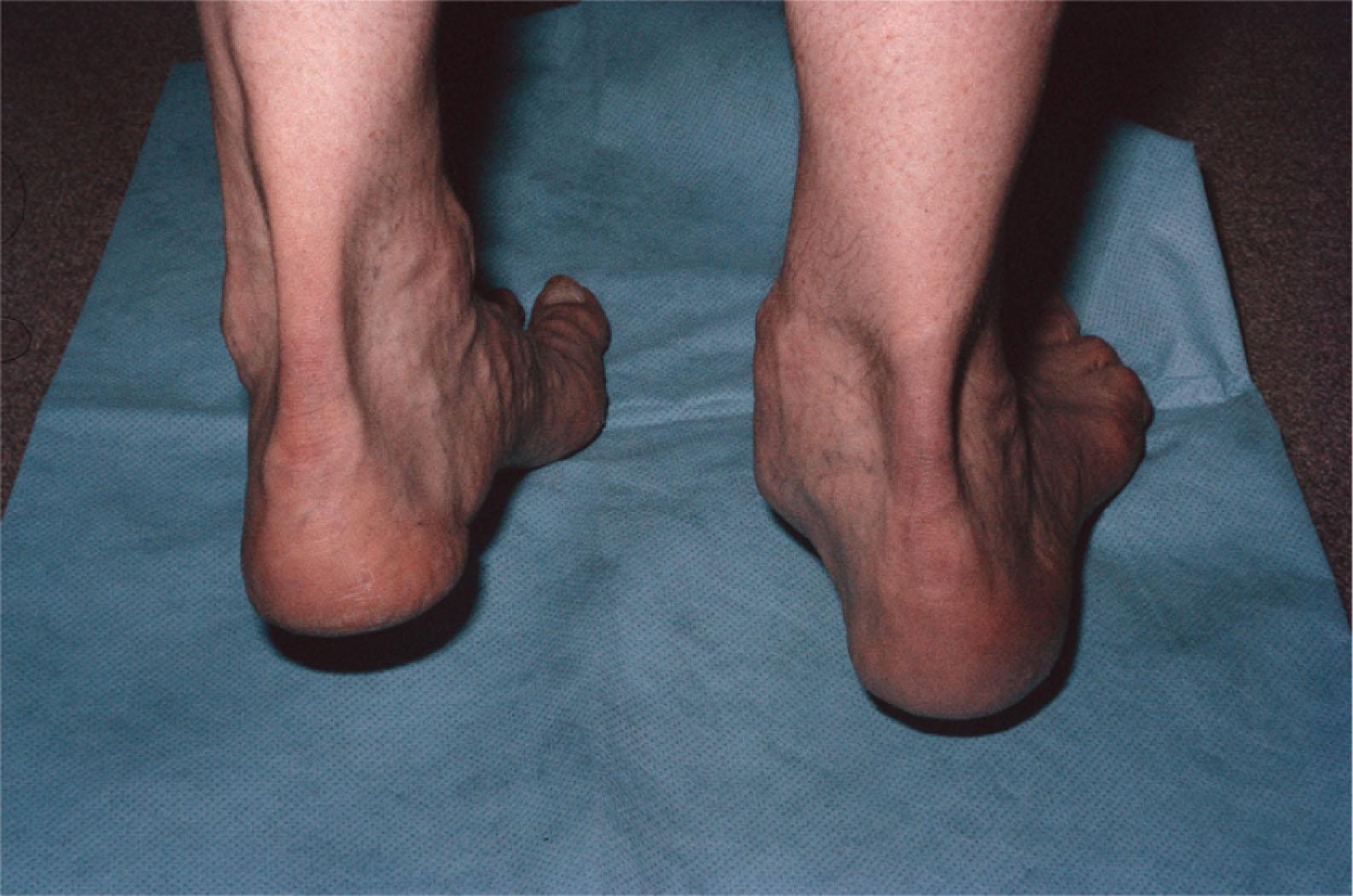
Returning to the truss theory, if a patient is able to remain standing on the toes without a functioning PTT, it is the plantar aponeurosis that brings about plantar flexion of the metatarsal heads and thus inversion of the calcaneus. In this theory, the longitudinal arch is maintained, and the gastrocnemius-soleus complex maintains the ankle joint in plantar flexion. Thus, patients without a functioning PTT may be unable to initiate standing on tiptoes but are able to maintain the position once they have gotten on their toes because the mechanism of action of the PTT is bypassed.
The examination now shifts to a seated patient. Passive range of motion of the ankle, subtalar, and the transverse tarsal joints is assessed. Excess mobility of the first metatarsocuneiform joint is assessed by firmly grasping both the first metatarsal and the midfoot and evaluating for subluxation of this joint surface in the sagittal plane. Simple dorsiflexion and plantar flexion of the first metatarsal while the midfoot is held rigid may be deceptive, and it must be compared with the opposite foot. Still, this maneuver may be useful for assessing midfoot pain and potential arthritis. This portion of the examination is also crucial to assess whether the deformity present is stiff or flexible. This is a crucial step in establishing staging of the deformity (see the staging discussion later) and can be a major factor in determining treatment.
Direct palpation along the course of the PTT can elicit pain, although in later-stage disease, where tendinopathy supersedes tenosynovitis, pain might not be present. The examiner feels for increased swelling, fluid within the sheath, and increased warmth. There is some suggestion that palpable pitting edema is a valid clinical finding supplanting the need for advanced diagnostic imaging. Retrospective analysis of this visible depression or deep indentation after direct pressure to the PTT found 86% sensitivity and 100% specificity of fluid within the tendon sheath confirmed via follow-up magnetic resonance imaging (MRI). Although the examiner can certainly make note of this finding on examination, clinical utility of this finding remains suspect because it may be evident only in inflammatory conditions leading to PTT dysfunction and has no predictive outcome on treatment.
Isolating the PTT for strength testing is difficult but possible. The examiner places the patient's ankle into a plantar-flexed position, everting the hindfoot, to negate the effect of the anterior tibial tendon. The patient must relax the toes to prevent overpull by the FHL and FDL. In this position, the patient inverts against resistance applied by the examiner's hand against the medial first metatarsal ( Fig. 29-3 ). Strength and reproduction of pain are noted and compared with the opposite extremity. Comparison is critical because patients can maintain some PTT strength with an incompetent tendon. As noted in the physiology section, the excursion of the PTT is only 1 to 2 cm. Thus, a length deficit of 1 cm because of rupture or tendinopathy can still provide some inversion strength while having no functional value.
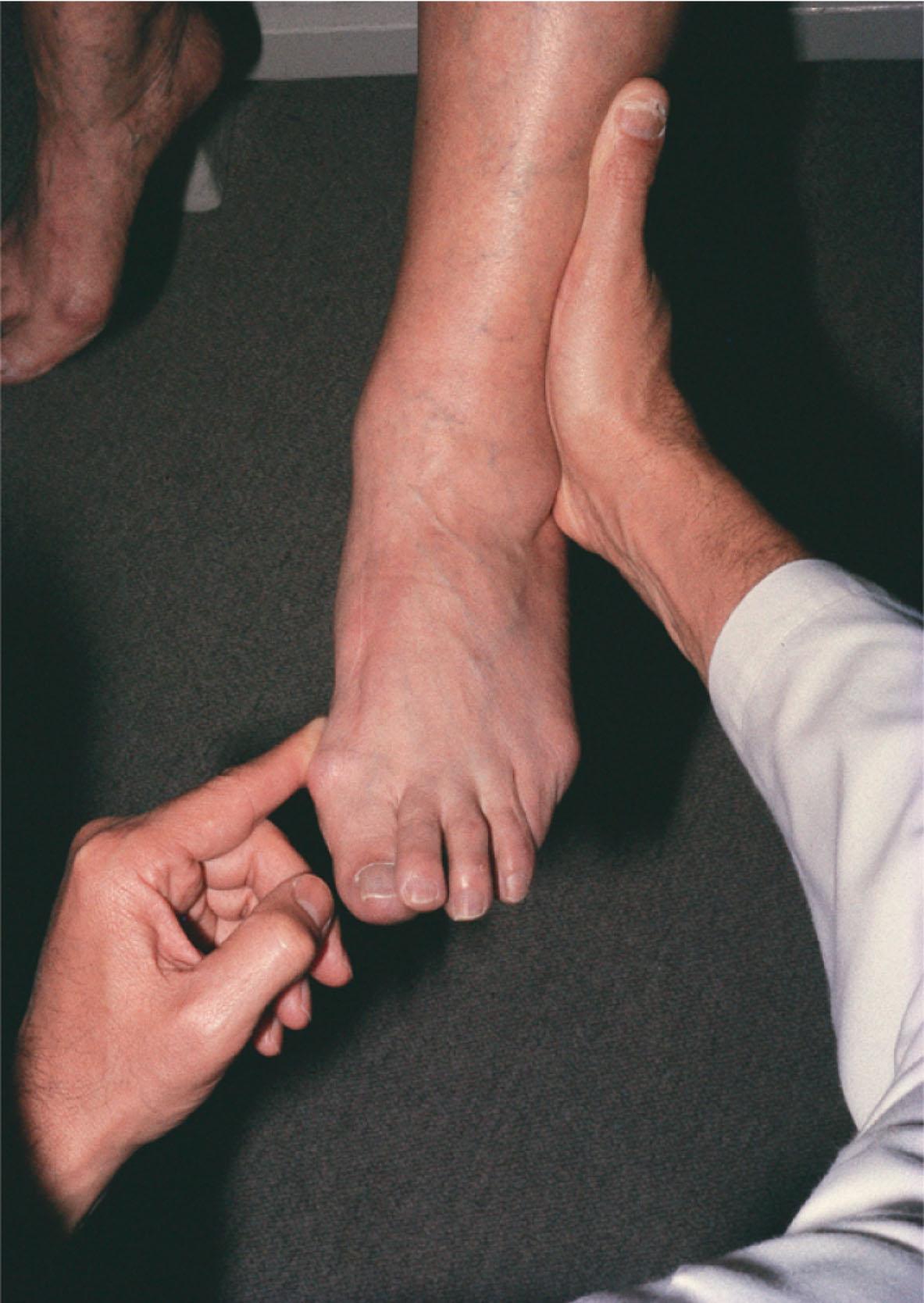
Inversion strength has been quantified by Houck et al via a subtalar inversion and forefoot adduction test using a force transducer and oscilloscope. The authors used the premise that muscle force assessment is directly related to the physiologic cross-sectional area of that particular muscle. The authors also sought to suppress the influence of the anterior tibial tendon on this tested plane of motion by plantar flexion of the ankle during testing. Quantification of this influence was determined by EMG data, confirming suppression of its impact to less than 10% normal inversion strength. The authors noted they were only able to keep only 60% of the control population and 40% to 50% of the diseased subjects from using less than 10% of the anterior tibial tendon in this plane of motion. With this in mind, the authors determined a 20% to 30% deficit in subtalar inversion and forefoot adduction strength, in those with flexible PTT dysfunction, versus control subjects. Whether a clinician can manually perceive this discrepancy during examination remains to be determined. However, this protocol can certainly be used to provide objective information during physical therapy, to assess strength recovery of the diseased PTT.
The patient is then asked to lie flat, and the ankle range of motion is assessed with the knee flexed and extended. The Silversköldt test specifically measures gastrocnemius contracture by alternately relaxing and incorporating the muscle because of its origin proximal to the knee joint. This test should be done while holding the subtalar joint in neutral, to avoid subtalar compensation for a tight gastrocnemius muscle.
With the legs fully extended and the subtalar joint held in neutral, an assessment for fixed forefoot varus is performed. In the normal foot, a line visually drawn across the plantar metatarsal heads is perpendicular to the long axis of the tibia and calcaneus. Patients can at times develop a varus deformity of the forefoot that allows the foot to compensate and meet the floor in response to hindfoot valgus ( Fig. 29-4 ). The visual metatarsal line is thus inclined medially. This can be a flexible deformity that corrects, or with progression a more fixed deformity. The rigidity of this condition may be evaluated by continuing to hold the subtalar joint in neutral while providing a manual dorsiflexion force on the lateral column of the foot through the fourth and fifth metatarsals. Normally, the lateral column of the foot is mobile, and the visual line should return to the anatomic axis. In fixed conditions, the medial inclination remains.
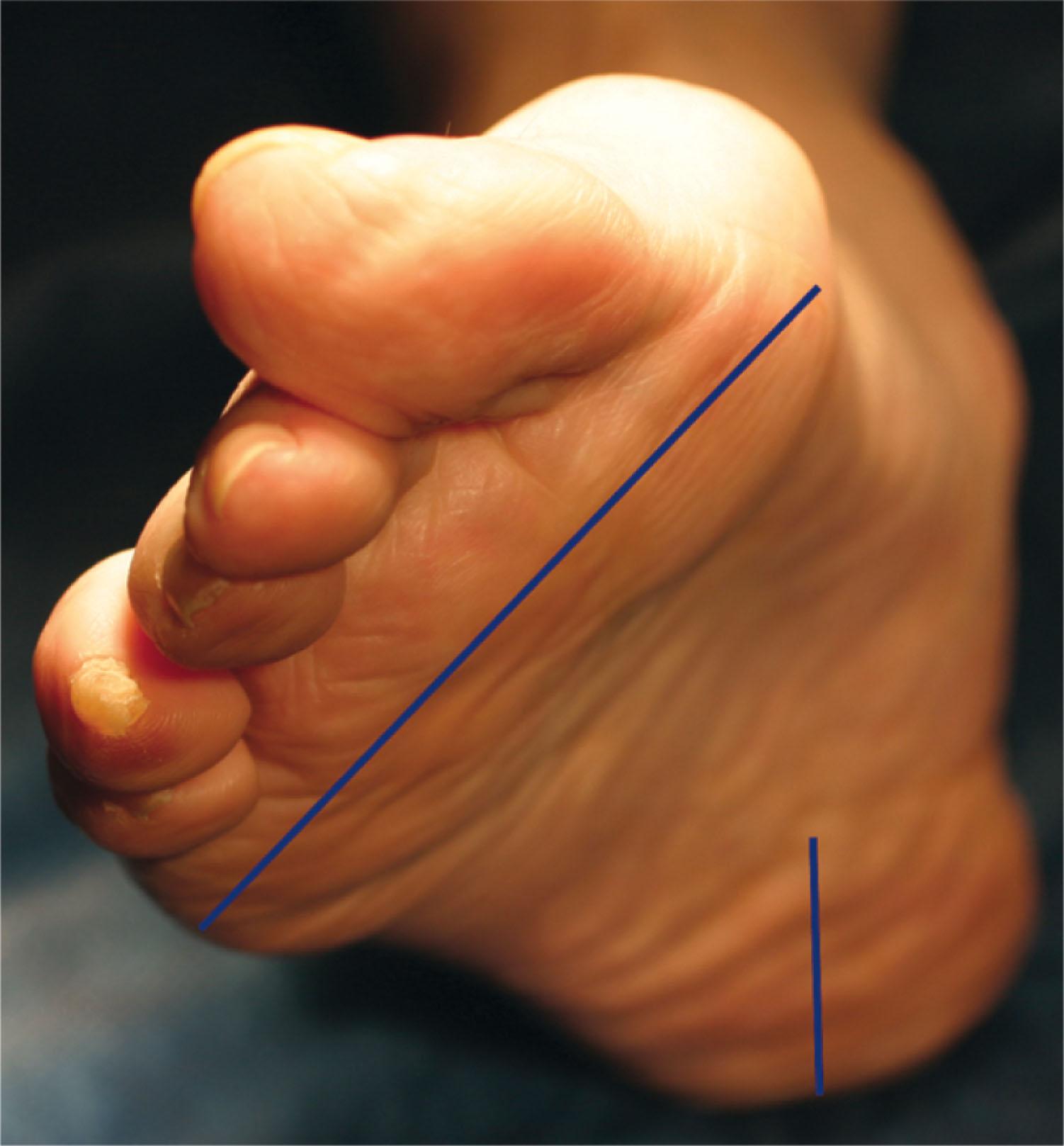
The patient is then placed in a prone position. Here, subtalar joint motion can be measured with the knee flexed 90 degrees and the ankle plantar flexed. Relaxing the gastrocnemius-soleus complex releases outside influence on the subtalar joint and allows accurate measurements to be obtained. This may be done with a goniometer, again placing one limb of the device along the axis of the distal tibia, the hinge at the talus, and the second limb along the axis of the calcaneus.
Finally, gait should be assessed through direct observation and formal analysis. A motion analysis system has been used, revealing prolonged stance phase and diminished stride length, cadence, and walking speed in PTT dysfunction. When segmenting regions of individual pathologic feet, the authors note that gait alteration can be explained through diminished dorsiflexion and increased eversion of the hindfoot, decreased plantar flexion of the forefoot, and diminished dorsiflexion of the hallux. The examiner can use this information in both surgical planning and in the manufacturing of orthotics or braces to support conservative care. Regardless, this dynamic component of assessment of PTT dysfunction is equally important to standing assessment and should be a part of every evaluation.
Before completing the examination, the patient's shoes are inspected for aberrant wear patterns. This becomes evident as medial heel wear in older shoes because valgus hindfoot asymmetrically erodes the heel through repetitive strike.
PCFD should be viewed as a syndrome in which there is a spectrum of clinical presentations and variations in individual anatomy and pathophysiology.
The most widely accepted and used classification scheme was proposed Johnson and Strom ( Table 29-1 ). The authors based this classification system on disorder, clinical presentation, and radiographic findings and centers around the function of the tibialis posterior tendon. It can be useful in organizing thoughts around treatment planning.
| Stage | Description |
|---|---|
| 1 | Tenosynovitis, no arch collapse |
| 2a | Flexible, mild arch collapse, able to single toe rise |
| 2b | Flexible, arch collapse, unable to single toe rise |
| 3 | Fixed, stiff deformity |
| 4 | Ankle joint tilt or arthritis |
Stage 1 patients present with swelling and pain along the medial aspect of the hindfoot, generally at the tip and distal to the medial malleolus along the course of the PTT. In this stage, tenosynovitis is the predominant source of pain. Thus the length of the tendon is preserved and, along with it, motor strength. The patient is usually able to perform a single toe raise, with normal varus tilt to the hindfoot while on the toes. This maneuver might not cause symptoms, but repetitive toe raises reproduce the symptomatic pain. With respect to the above-mentioned parameters in physical examination, hindfoot valgus is absent, too-many-toes sign is absent, and deformity is absent.
Stage 2 patients have undergone elongation and degeneration of the PTT. Deformity of the foot is obvious at this stage. The hindfoot is in valgus, and the forefoot may be in abduction. Collapse at the talonavicular joint is apparent. The patient may be able to perform a single-limb heel rise early in this stage, but as the deformity progresses, the patient is unable to do so. Most important, the deformity remains flexible at this stage. Thus, the examiner can passively correct both the hindfoot valgus and forefoot abduction while the patient is seated. Recently, this stage has been subclassified into an “a” stage, where symptoms are primarily medial, the collapse is mild, and the patient can still perform a single-limb heel rise, and a “b” stage, where subfibular impingement develops along with complete incompetence of the PTT.
Stage 3 patients have developed a rigid deformity. Forefoot varus is fixed and usually 10 to 15 degrees at the minimum. The subtalar joint no longer reduces in a seated position, and any attempt to place the calcaneus in the anatomic axis reveals the compensatory supinated forefoot. The gastrocnemius-soleus complex is tight. Often the medial ankle pain is absent in this stage, and patients complain more of pain in the lateral ankle, which, upon examination, is subfibular. Pain at rest might become apparent as arthritis becomes a component of the condition. The patient is unable to perform a single-limb heel rise.
Stage 4 was added by Myerson. Chronic eccentric loading of the ankle joint in valgus creates lateral compartment arthritic wear patterns. The lateral ankle pain with which a patient in stage 3 would present is now only partially subfibular impingement and more directly related to ankle arthritis. This valgus load eventually leads to a valgus deformity of the talus and attenuation of the deltoid ligament.
Since Strom proposed this classification scheme, there has been increased recognition of the variation in deformity of the midfoot, hindfoot, ankle, and injury to the tibialis posterior tendon as well as other ligaments not addressed in this classification scheme. A recent expert consensus group proposed not only the changing nomenclature of tibialis posterior tendon dysfunction, or adult acquired flatfoot to PCFD, but also proposed a new classification scheme. This classification scheme is based on the flexibility or lack of flexibility and the location of the deformity present ( Table 29-2 ). The proposed benefit of this newer classification is that it allows for expanded classification schemes based on the individual that then can lead to a better informed and appropriate surgical treatment. It provides a more descriptive framework for describing pathophysiology by separating suppleness from anatomic location of deformity. Stages describe suppleness, with stage 1 being flexible and stage 2 being rigid. The areas of deformity are described as A-E based on the deformity type (see Table 29-2 ). The deformity can also be classified as isolated or combined. However, this recently proposed change in nomenclature and classification has not yet been validated.
| Stage | Class | Deformity Type/Location | Clinical/Radiographic Findings |
|---|---|---|---|
|
A | Hindfoot valgus |
|
| B | Mid/forefoot abduction | Decreased talar head coverage | |
| C |
|
|
|
| D | Peritalar subluxation / dislocation |
|
|
| E | Ankle instability | Ankle valgus tilt |
Weight-bearing radiographs are used to appreciate the deformity, and they are useful in proposing management options. The standard series includes three views of the foot and, at the very least, an anteroposterior (AP) or mortise view of the ankle ( Figs. 29-5–29-7 ). These images are considered the gold standard for assessment of the deformity and the minimal needed to making an accurate staging. Additional radiographs can include a complete ankle series ( Fig. 29-8 ) and a hindfoot alignment radiograph ( Fig. 29-9 ). Patients who have a congenital flatfoot should undergo radiographs of the opposite foot for comparison.
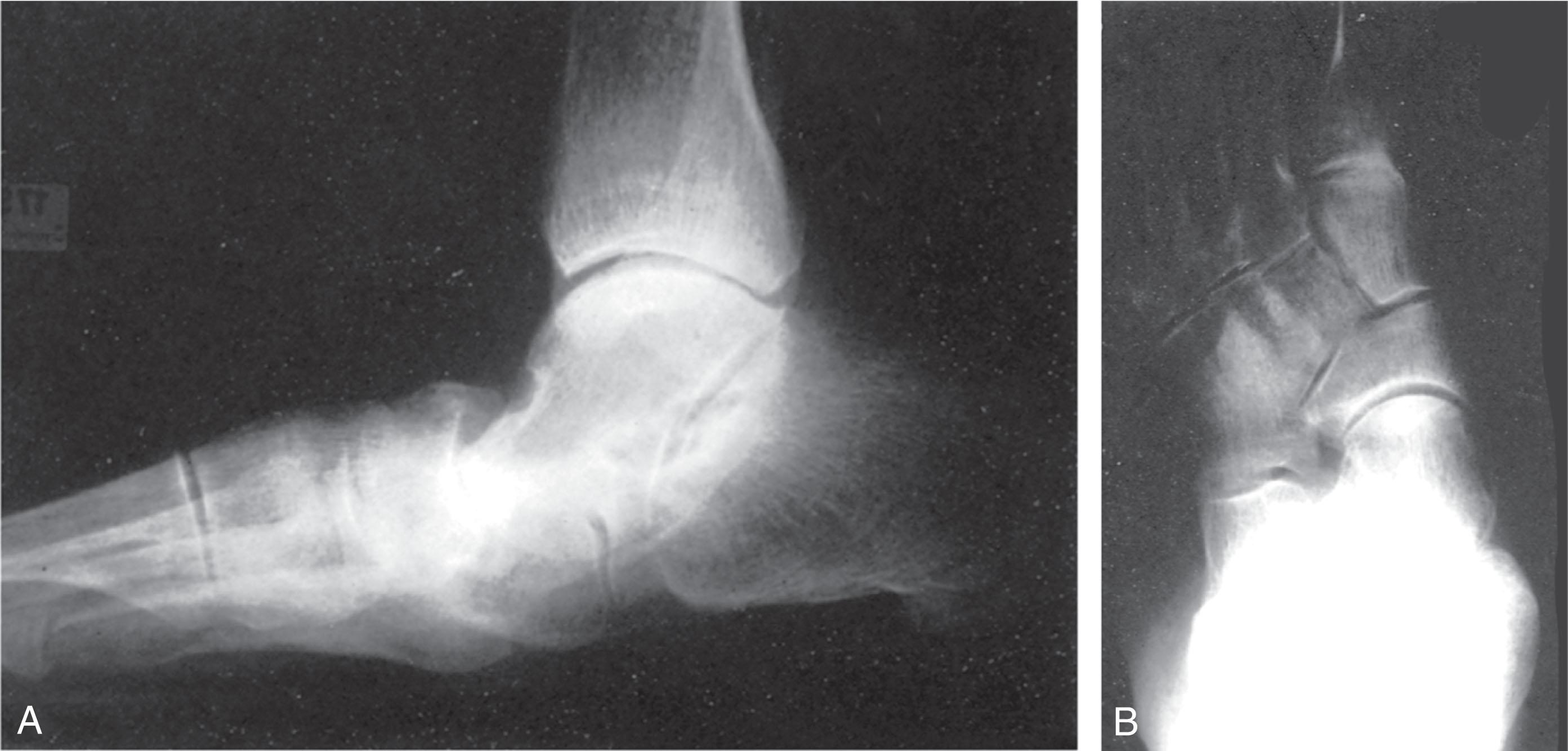
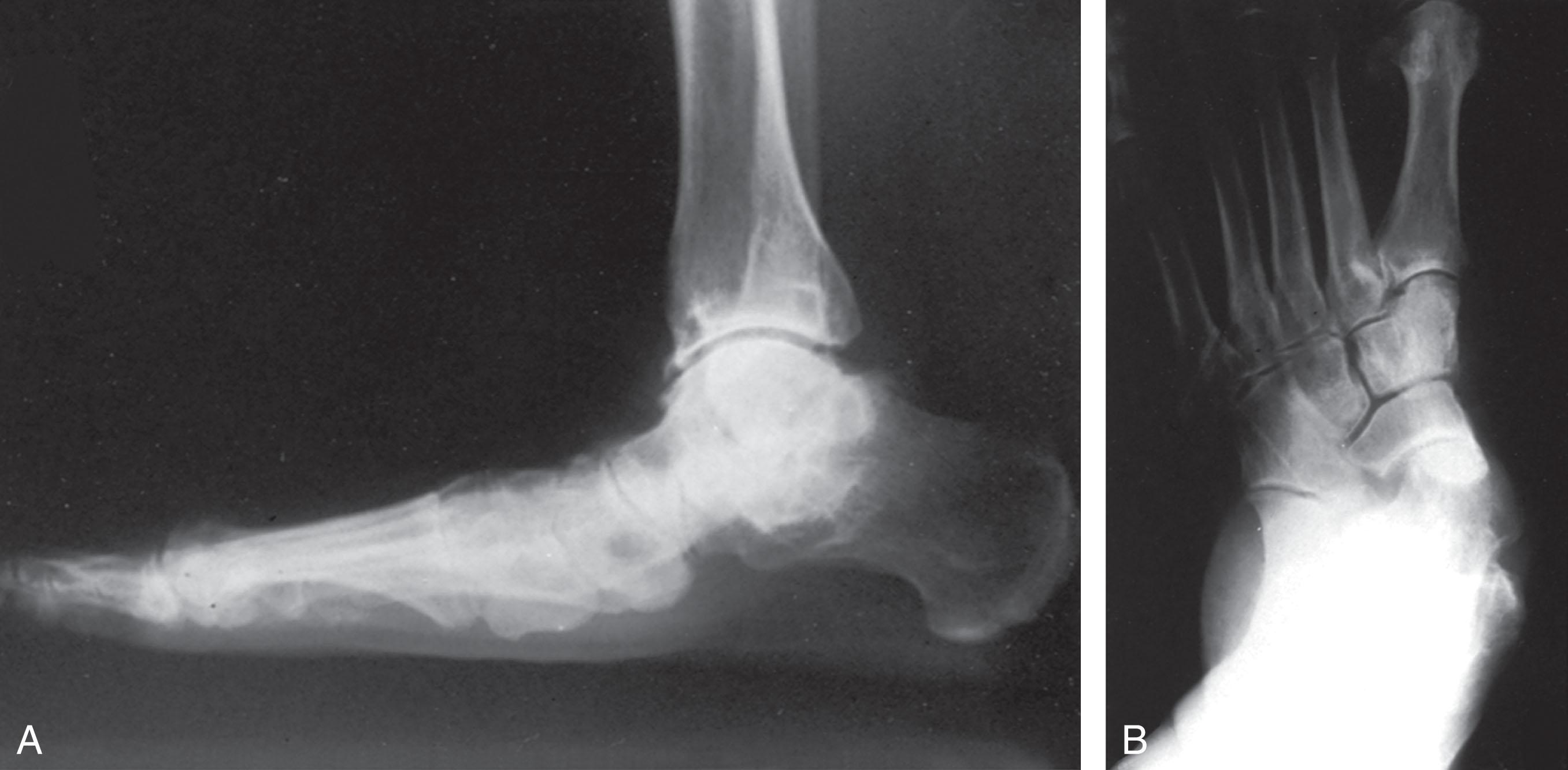
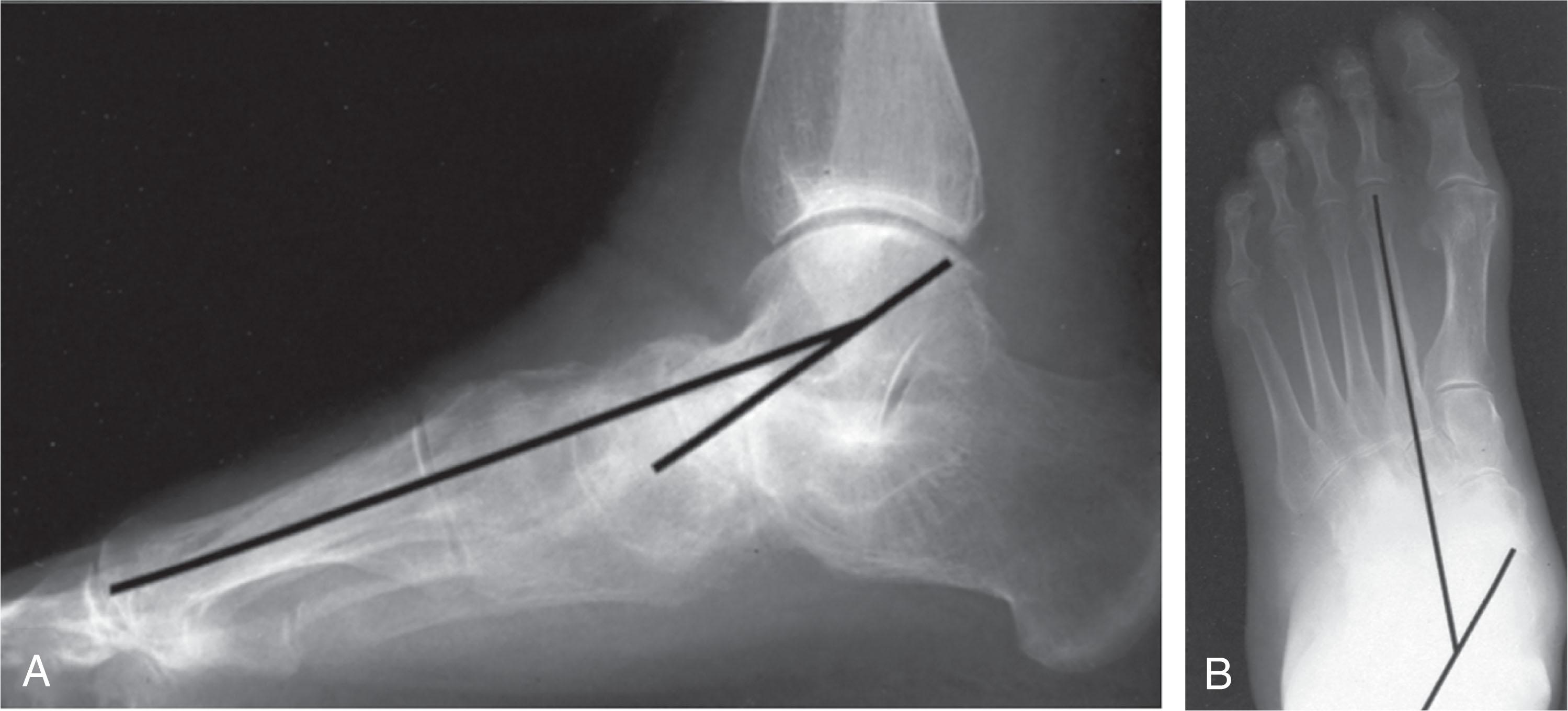
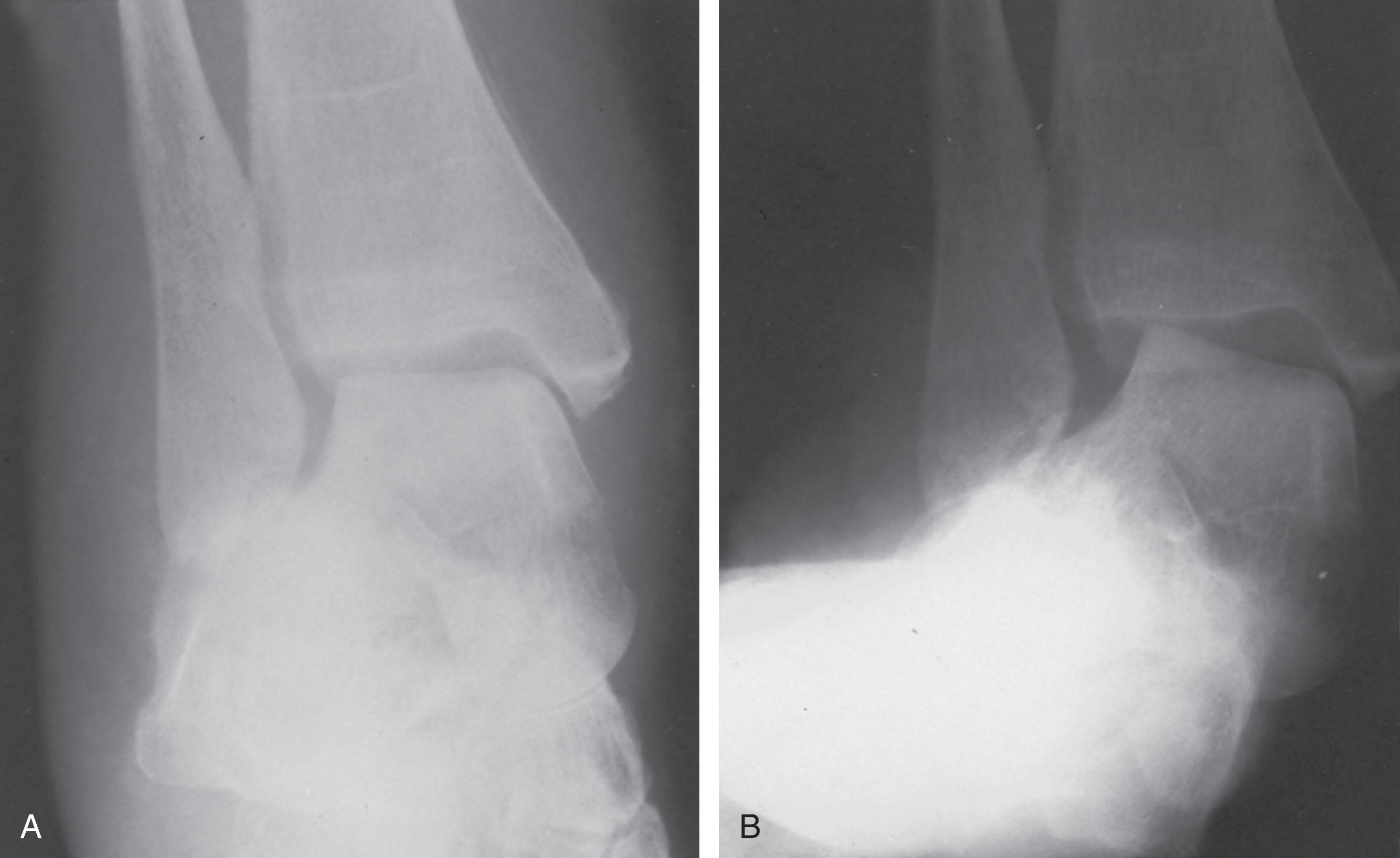
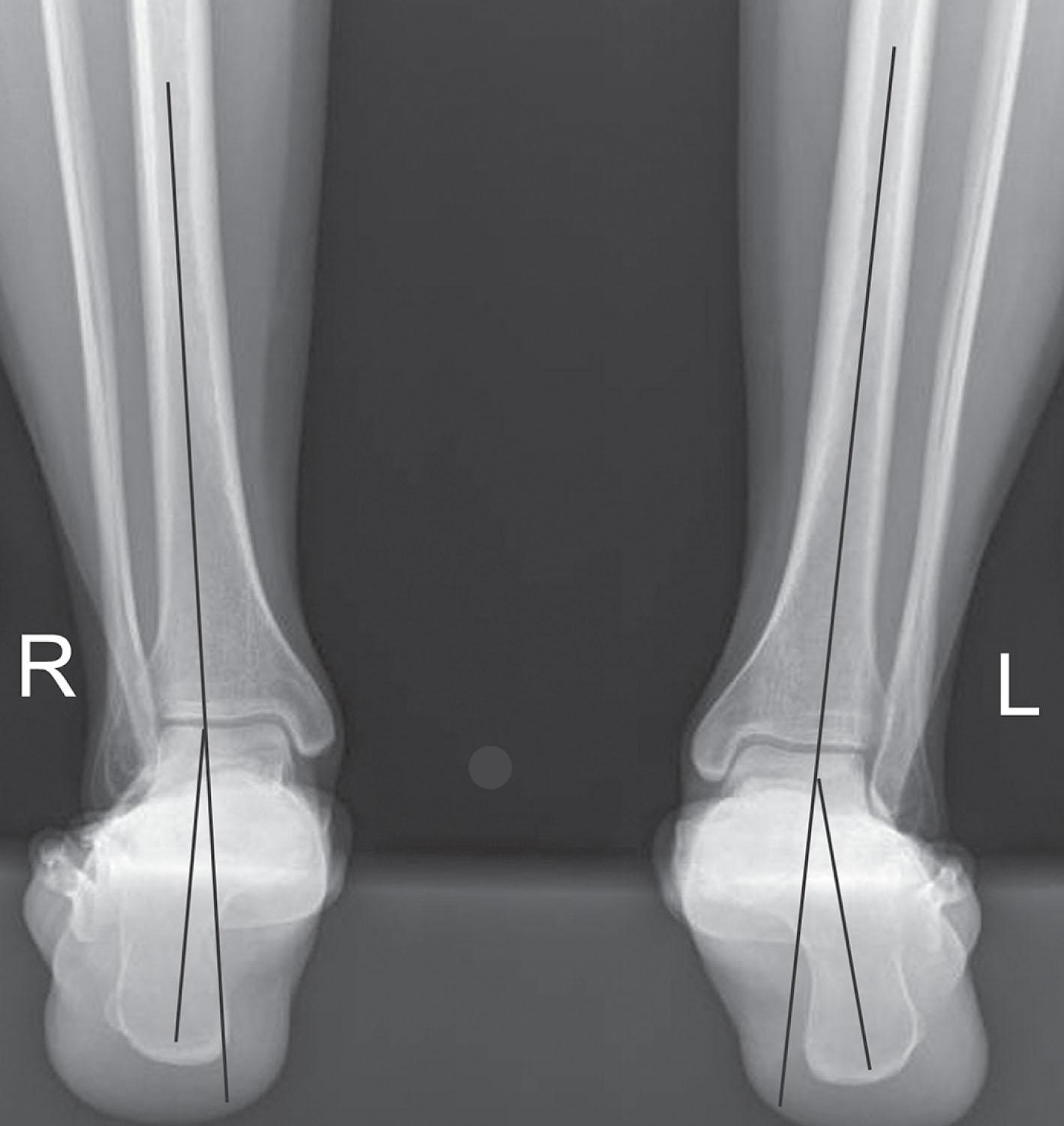
Even in patients with minimal deformity, weight-bearing x-rays can be useful to rule out structural diagnoses that could be contributing to the patient's flatfoot and pain. Tarsal coalition, degenerative arthritis, accessory navicular, and old trauma, such as a Lisfranc injury, can contribute to this constellation of symptoms. The weight-bearing radiographs are also very useful in assessing the specific areas of deformity of the foot. In a general sense, lateral subluxation of the talonavicular joint is evident on the AP radiograph, and talonavicular joint sag is noted on the lateral radiograph. The lateral radiograph also provides useful information about the status of the first metatarsocuneiform joint because subluxation or arthritis of this joint surface can contribute to the flatfoot ( Fig. 29-10 ). Subluxation also occurs at the subtalar joint, manifested as an indistinct joint surface on the lateral film. Ankle radiographs can demonstrate arthritis and subfibular impingement ( Fig. 29-11 ).
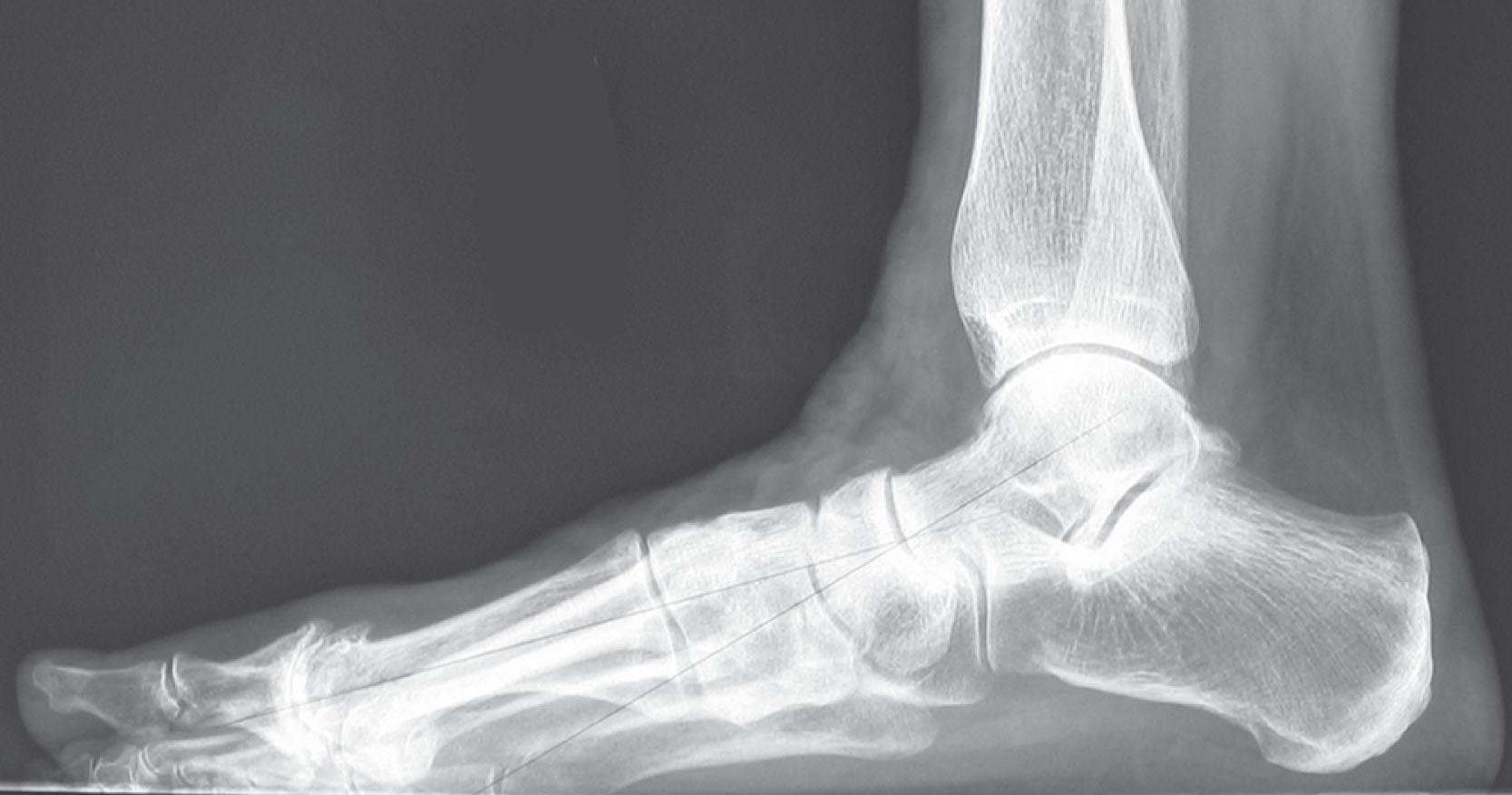
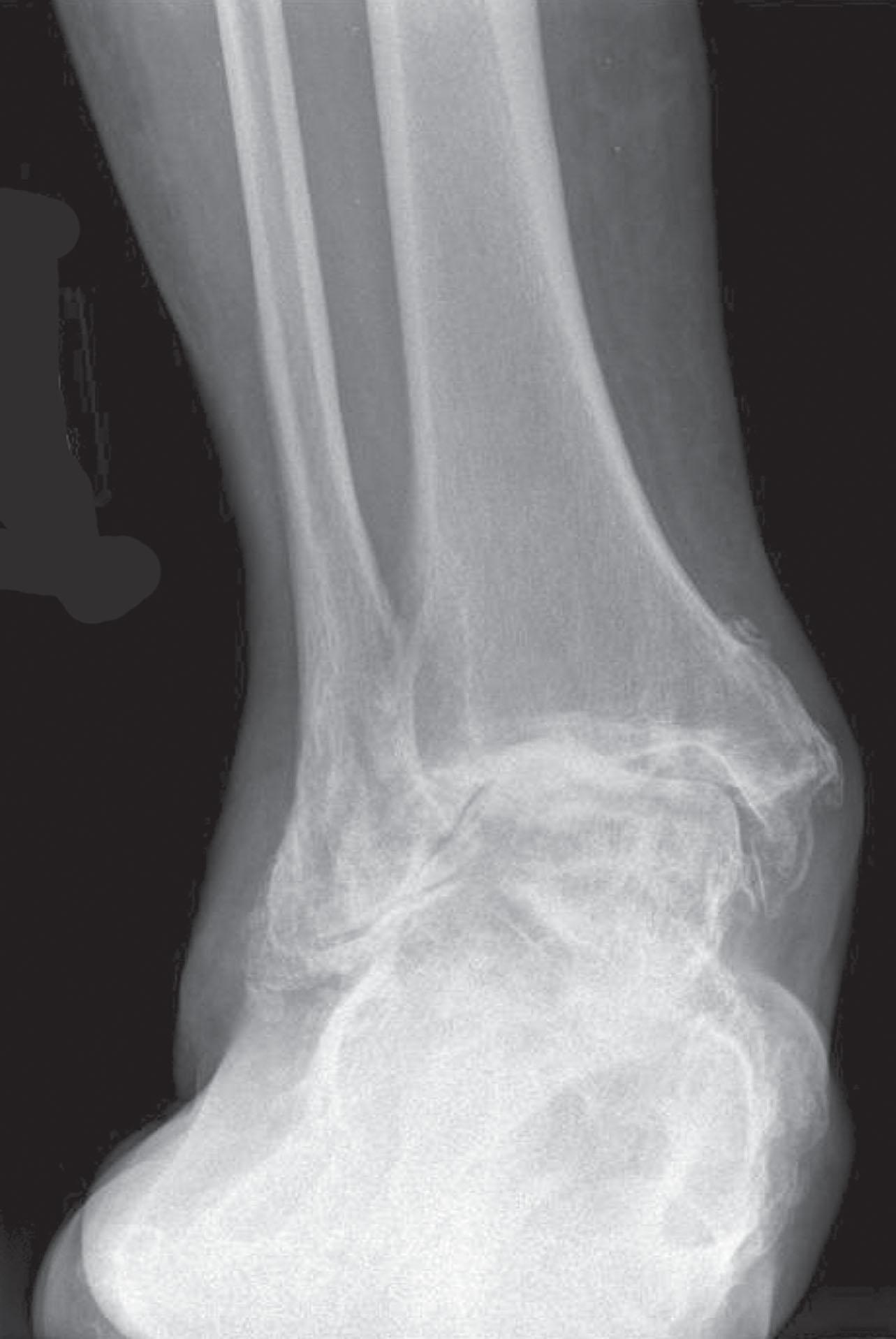
To quantify these findings, measurements have been proposed that assist in static assessment of the disorder, while enabling the surgeon to follow progression. In addition the measurements of weight-bearing radiographs have shown excellent inter- and intraobserver reliability between clinicians.
Sangeorzan et al suggested that, on the lateral radiograph, the important parameters are the lateral talocalcaneal angle, the lateral talometatarsal angle, and the cuneiform height. The lateral talocalcaneal angle is indicated by a line drawn midway between the superior and inferior portions of the talar body and neck and a second line drawn midway between the superior and inferior portions of both the tuberosity and the sustentaculum tali (see Chapter 3 ). The lateral talometatarsal angle is measured using the same line through the talus as for the lateral talocalcaneal angle and a second line drawn along a point halfway between the superior and inferior portions of the proximal and distal metaphyseal–diaphyseal junction of the first metatarsal (avoiding inconsistencies with the flares distally and proximally). Cuneiform height is measured between the medial cuneiform and the fifth metatarsal base. Cuneiform height can also be measured between the medial cuneiform and the ground, which is less sensitive. Arangio et al demonstrated that the medial cuneiform height as viewed on weight-bearing radiographs was significantly different (11.04 mm) compared to healthy controls (18.38 mm), indicating its use in determining patients with PCFD.
On the AP view, the important parameters are the talocalcaneal angle, the talometatarsal angle, and the articular congruity angle. The talocalcaneal angle uses a point midway between the medial and lateral articular surface and a second point midway between the margins of the talar neck. This line intersects with a line drawn along the lateral border of the calcaneus (see Chapter 3 ). The talometatarsal angle uses the talus as one axis (with the lines drawn in an identical fashion to that on the sagittal image). The second axis is drawn in the first metatarsal, midway between two points measured along the metaphyseal–diaphyseal junction (proximal and distal). The articular congruity angle is measured by first drawing a line connecting the articular margins of the talus and navicular. A perpendicular line is drawn at the midpoint of each line. The angle created by the intersection of these two lines represents talonavicular coverage.
Normal values for these angles include an assessment by Gould, who suggested that the lateral talometatarsal angle should fall between −4 degrees and +4 degrees. Saltzman suggested that 95% of the population has a talocalcaneal angle of less than 12 degrees. The lateral talocalcaneal angle increases in patients with acquired flatfoot, as does the talometatarsal angle.
Computed tomography (CT) scans have become increasingly useful for understanding and classifying patients with progressive collapsing foot disorder (PCFD) especially as weight-bearing CT scans have become more readily available and widely used. Though non–weight bearing CT scans can be helpful in understanding bony anatomy, presence of arthritis, and to look for coalitions, the superiority of weight-bearing CT scans have been demonstrated in multiple studies for the evaluation of PCFD patients. In general, a weight-bearing CT scan can provide all of the angles and measurements that weight-bearing radiographs can provide, but also add further three-dimensional detail that radiographs cannot, in particular around lateral impingement, peritalar subluxation, and the anatomy of the subtalar joint.
Weight-bearing CT scans have been used in PCFD patients to better quantify and understand the deformity present within the subtalar joint, in relation to the subluxation of the facet joints. Kunas et al demonstrated subluxation in the anterior/middle and posterior facets compared to controls where the subluxation within the middle facet was most pronounced. This has been reinforced by more recent work that has demonstrated high reliability of the middle facet in assessing peritalar subluxation in patients with PCFD. Other researchers have demonstrated findings of increased subluxation within the posterior facet. For patients with PCFD and lateral hindfoot pain, weight-bearing CT scans have also shown good efficacy in demonstrating and evaluating sinus tarsi and subfibular impingement, helping to assess the cause of pain.
Improved evaluation of the anatomy of the subtalar joint, and in particular the posterior facet, in PCFD patients has also been enhanced through the use of weight-bearing CT scans. This has led to an important and evolving understanding of the relationship that the anatomy of the joint might play in disease progression. Colin et al demonstrated that the normal orientation of the posterior facet curves gently to become more angulated into a valgus position posteriorly. Patients with PCFD, however, show increased inherent valgus orientation to their posterior facets, in particular demonstrating a valgus orientation throughout the posterior facet from anterior to posterior. This more valgus orientation of the subtalar joint has also correlated well with other radiographic parameters of deformity, leading to the conclusion that an increased valgus orientation of the posterior facet may be a major risk factor for developing PCFD or progression of symptoms.
These recent studies have demonstrated the utility of weight-bearing CT scans in evaluating PCFD. For this reason, whenever possible, a weight-bearing CT scan should be used in the evaluation of PCFD.
MRI is an excellent modality for detecting sheath inflammation, soft tissue resolution, and anatomic detail of tendons as well as ligaments and cartilage. It is superior to CT for tendon definition, resolution of synovial fluid, soft tissue edema, and tissue degeneration. Furthermore, tendon thickness and cross-sectional area may be used to differentiate normal from tendinopathic PTTs, and pathologic tenosynovial fluid may identify patients with early stage 1 disease before morphological tendon changes occur. For these reasons, MRIs can be useful in evaluating the quality and pathology with the tibialis posterior tendon, as well as the spring and deltoid ligaments, especially in settings with more minor deformity or tendonitis without attenuation where weight-bearing x-rays or weight-bearing CT scans are not as predictive. Though MRI may be useful, it is not as essential as weight-bearing x-rays or typically as useful as a weight-bearing CT scan in making clinical decisions and can be misleading in cases with considerable tenosynovitis. Part of this relates to the lack of weight bearing during a typical foot or ankle MRI. If technology evolves to allow for weight-bearing MRIs, then the utility of MRI in assessing PCFD will likely evolve with it.
Alexander et al first discussed MRI’s usefulness in a 1987 case report on a 44-year-old patient with a complete rupture of her PTT, as diagnosed by MRI and confirmed at surgery. Rosenberg found the sensitivity of MRI versus CT is 95% versus 90%, the specificity of MRI versus CT is 100% and 100%, and the accuracy of MRI versus CT is 96% versus 91%. Elusive longitudinal split tears not visualized on CT scanning were easily seen with MRI scanning. Thus, the percentage of tears that were diagnosed and classified correctly was greater with MRI (73%) than with CT (59%).
Normal tendon substance on MRI appears as a black and homogenous signal with an ovoid shape on all spin-echo images. This appearance is due to the dense collagen within the PTT. The PTT is normally two to three times larger than the FDL tendon. A small amount of fluid within the sheath is normal, although it should not be more than 1 to 2 mm wide, and it should not be circumferential. In tenosynovitis, T2-weighted images show pronounced fluid surrounding the tendon and edema within the tendon sheath. The synovial effusion appears as a bright signal and is best seen on T2 images.
The hallmark of tenosynovitis is a homogenous tendon with fluid in the tendon sheath. T1 images are useful for evaluating the synovial membrane and the substance of the PTT ( Fig. 29-12 ). These structures are hypertrophied, and the PTT occasionally reaches sizes 5 to 10 times that of the adjacent FDL tendon. T1 images also evaluate intratendinous disorders by showing foci of increased signal, revealing longitudinal split tears. The synovial sheath of the PTT ends before its insertion. Thus, there is no true tenosynovitis noted distally. Increased signal around the tendon close to its insertion is peritendinitis and is not normal. The width of the synovial sheath is significantly increased in PTT tenosynovitis.
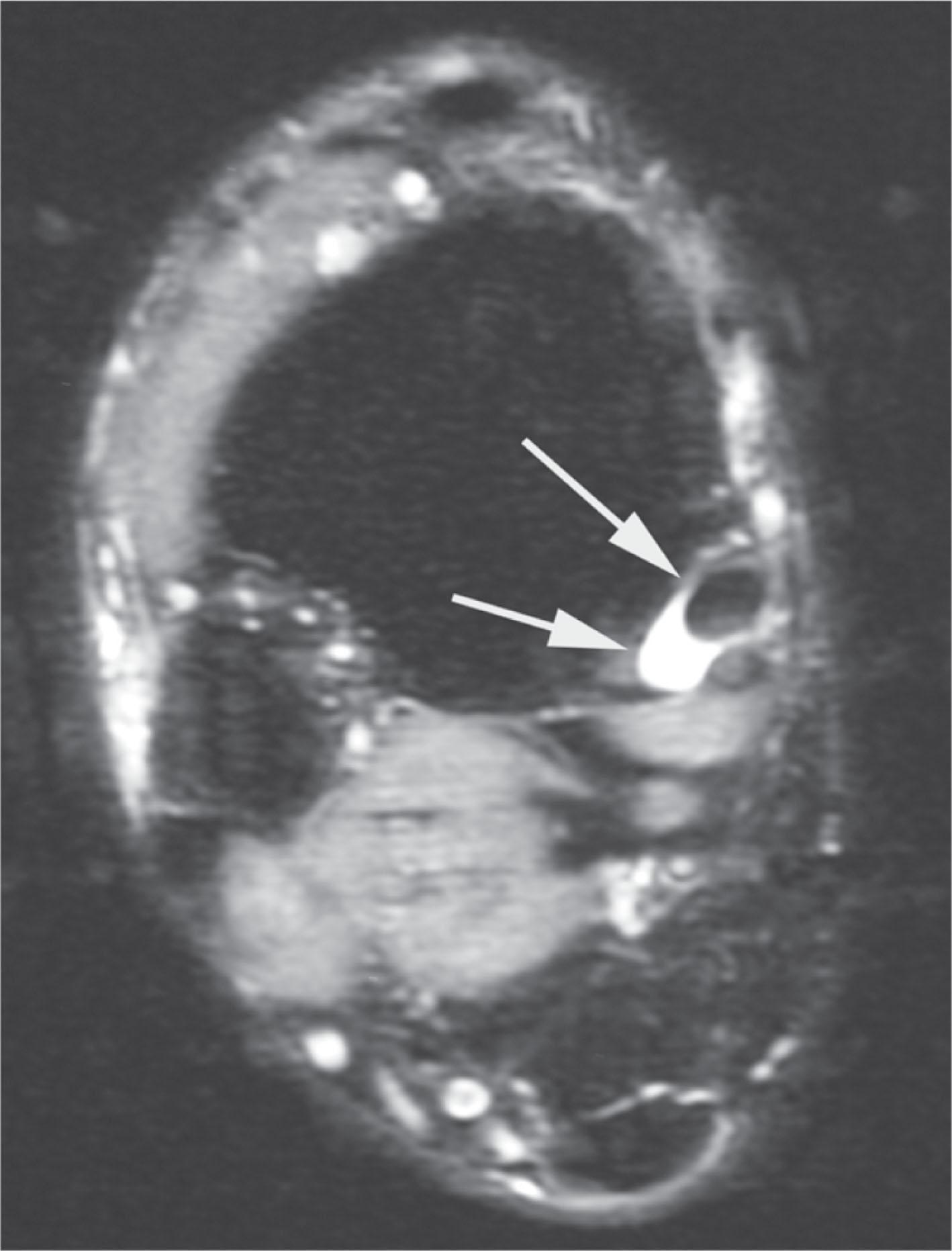
Elongation of the tendon becomes apparent on MRI as the patient’s disease progresses. The diameter of the tendon might in fact be less than the adjacent FDL tendon, or a complete rupture of the tendon can be visualized. T2-weighted images can reveal increased signal consistent with edema in the sinus tarsi. Balen and Helms found such changes in the sinus tarsi in 72% of patients who have PTT dysfunction (vs. 36% of control patients scanned for ankle pain).
MRI findings around the tibialis posterior tendon can be useful in surgical planning. Wacker et al studied the physiologic quality of both the posterior tibial and FDL muscle belly in patients with PCFD. The authors found that in patients with a complete rupture of the PTT, the muscle belly underwent significant fatty infiltration. This nonfunctional muscle was noted within 10 months of the injury, having created complete rupture. Those patients with posterior tibial tendinosis without complete rupture demonstrated a mean of 10.7% for atrophy of the muscle belly, with compensatory hypertrophy (mean, 17.2%) of the FDL muscle belly. This can be useful in planning tendon transfers or other reconstructive procedures.
The plantar calcaneonavicular ligament (spring ligament) has also been studied with MRI ( Fig. 29-13 ). Yao had independent radiologists evaluate MRI studies done preoperative ly on patients who had intraoperative findings of spring ligament insufficiency. The MRI evaluations were done retrospectively, after definitive surgical confirmation of disorder. The control population in this series was patients without spring ligament disorder. The radiologists consistently found signal heterogeneity on axial short TE (T1-weighted) within the medial portion (superomedial calcaneonavicular) of the ligament only. Rather than finding an attenuated ligament, the medial ligament was thickened to more than 5 mm. Poor correlation between radiologists was noted with the plantar (inferior calcaneonavicular) ligament. This ligament is inherently thin, and MRI evaluation was unreliable. Biomechanical studies demonstrate that this component of the ligament plays a minor role in statically stabilizing the longitudinal arch. Overall, the sensitivity for evaluation of the medial ligament was 54% to 77%, and the specificity was 100%. Note that this evaluation was done on chronic ligament disorders, not acute ruptures. In the latter scenario, the MRI diagnosis is more reliable because T2-weighted images demonstrate bright foci consistent with edema and hematoma.
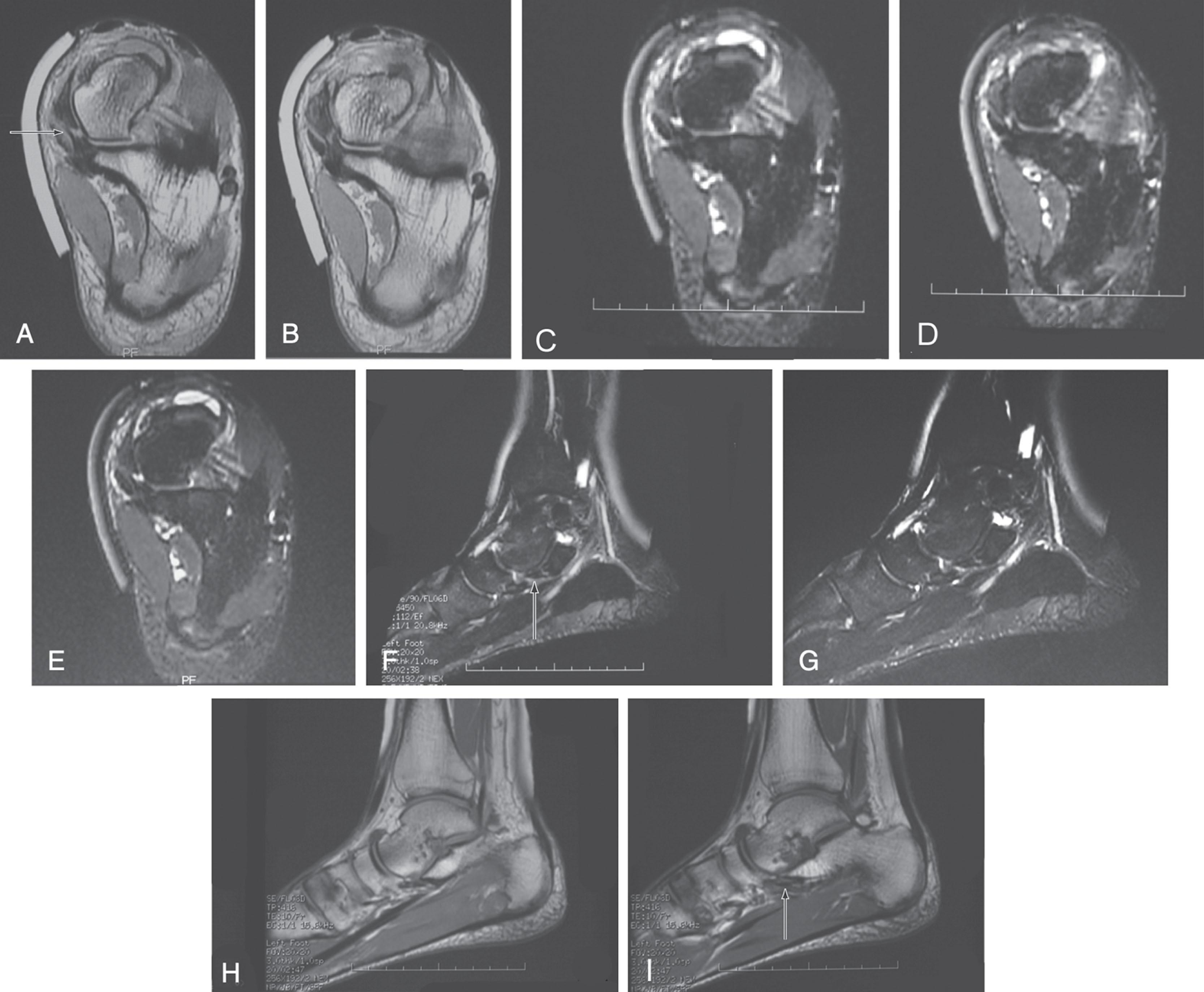
Despite the lack of weight bearing, lateral hindfoot impingement (sinus tarsi or subfibular) can also be assessed via MRI. Sinus tarsi impingement was seen at the opposing surfaces of the lateral talar process and the lateral wall of the calcaneus, manifesting as marrow edema, cystic change, or sclerosis. Subfibular impingement was evident as soft tissue entrapment or osseous contact between the fibula and calcaneus, or marrow edema of the fibula. T2-weighted images can reveal increased signal consistent with edema in the sinus tarsi. Balen and Helms found such changes in the sinus tarsi in 72% of patients who have PTT dysfunction (vs. 36% of control patients scanned for ankle pain).
Ultrasonography is now recognized as a cost-effective and accurate modality for evaluating tendon and some ligament disorders in the foot and ankle. This can be especially useful in patients with symptoms consistent with tibialis posterior tendonitis or split tears within the tendon. Caution should be employed, however, as the need for an experienced ultrasonographer is needed for ultrasound to be utilized effectively, and this modality will not substitute for weight-bearing radiographs or a weight-bearing CT scan when evaluating alignment.
A normal tendon appears hyperechoic, and a degenerated tendon is hypoechoic on ultrasound imaging ( Fig. 29-14 ). Normal PTT diameter is 4 to 6 mm. Tenosynovitis manifests with large amounts of fluid surrounding the tendon. A hypoechoic rim visible on the longitudinal sonogram and a target sign on transverse sonogram is pathognomonic for PTT tenosynovitis. The term target sign was coined to describe a homogeneous, continuous hyperechoic tendon surrounded by a hypoechoic fluid halo. The halo represents excessive surrounding synovial fluid. Ultrasonography can also reveal a swollen tendon, an irregular tendon contour, longitudinal split tears, heterogeneous echogenicity, and surrounding hypoechoic shadows in patients with tenosynovitis. In contrast, tendon rupture features an empty tibial groove at the level of the medial malleolus.
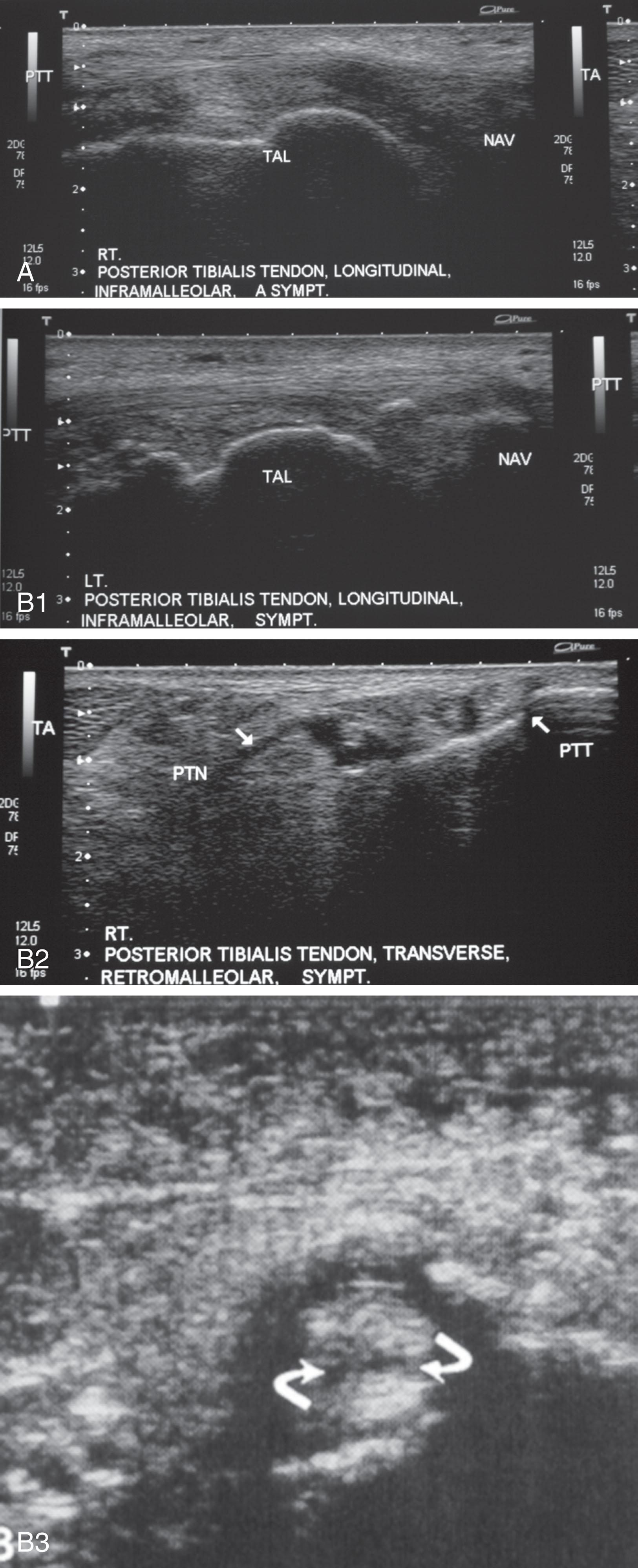
Chen and Liang have shown that on average the PTT measures 3.30 mm in diameter. A tendon afflicted with tenosynovitis averages 4.61 mm. In addition, an increased synovial sheath diameter is noted in tenosynovitis and is a reliable marker for predicting intraoperative findings. The average diameter of a normal tendon sheath is 3.64 mm. In tenosynovitis, the measurement increases to 7.24 mm ( P < 0.0001). Therefore, ultrasonography will detect both a mildly enlarged tendon and a significant increase in sheath diameter resulting from fluid accumulation.
Chen and Liang confirmed their ultrasound findings through surgical exploration. All 14 patients with PTT tenosynovitis requiring surgical exploration had an intact PTT and surrounding fluid and hypertrophic tenosynovium. Although this study entertained no false-positive results, the authors caution that misdiagnosis may be common in the hands of an inexperienced examiner reviewing longitudinal scans. The authors suggest that ultrasonography is superior to MRI based on speed, convenience, low cost, and its dynamic nature. This study is limited, however, by lack of double-blinding because the surgeon was given the ultrasound results in advance of the operation, potentially influencing intraoperative findings.
Studies have suggested that sensitivity and specificity for ultrasonography is similar to those for MRI. Miller et al surgically explored 17 patients with PTT tenosynovitis who had undergone preoperative ultrasound examination. The authors found ultrasonography successful in confirming intraoperative findings in all 17. They concurrently performed preoperative MRI examinations on these 17 patients. Two patients with tendon damage visible on surgical exploration had normal tendon readings on MRI.
Gerling et al performed a double-blinded study on fresh cadaveric feet, creating longitudinal split tears in the PTT. Four separate scans were done on each cadaveric limb, the first with no tear, followed by progressively creating a split tear of 1, 2, and 4 cm in length. Each limb was evaluated with ultrasonography and MRI. The authors found the sensitivity of MRI versus ultrasonography was 73% versus 69%; the specificity of MRI versus ultrasonography was 69% versus 81%; and the accuracy of MRI versus ultrasonography was 72% versus 72%. Interobserver reliability was excellent with MRI (0.86) and only fair with ultrasonography (0.37). It remains difficult to interpret the clinical value of this study because the absence of in vivo perfusion and physiologic tendon function alters the natural environment of these radiographic modalities. The significant deviation from prior studies evaluating MRI sensitivity and specificity echo the questionable validity of this cadaveric study.
Additional comparative imaging between MRI and ultrasonography in patients with spring ligament pathology are supplied by Harish et al. The authors evaluated 16 patients with tibialis posterior tendon dysfunction, comparing the readings on both MRI and ultrasonography. The studies were symmetric in their interpretation 94% of the time. Within statistical significance, they were equivalent in diagnosing spring ligament disruption in patients with preexisting PTT insufficiency.
In most instances, conservative therapy should be instituted before contemplating surgical reconstruction for PTT insufficiency. Although a standard protocol has not been developed and would inherently depend on the stage of the disease when the patient presents at the office, in particular assessing the flexibility of deformity and areas involved, common themes are recognized that involve rest of the tendon, medication, physical therapy, and management of orthotics and braces.
For patients with pain along the PTT, resting or relieving the tension on the PTT may be done in a graduated fashion. The first level of rest involves a rigid stirrup brace or lace-up sport brace. This type of brace crosses the ankle joint and thus limits excursion of the PTT. However, it offloads only the inversion component to PTT activation, ignoring restriction on sagittal motion. Thus, the PTT still glides within the sheath, allowing further aggravation from inflammation and repetitive stress. Still, in more mild conditions, unloading inversion may be sufficient for pain relief.
If the first level of rest is ineffective, patients may wear a controlled ankle movement (CAM) walker boot. This device has the added benefit of eliminating motion in the sagittal plane. It retains the advantage over casting by allowing simultaneous functional rehabilitation as well as removal for bathing. A below-knee cast, however, provides ultimate tendon rest and absolute compliance. Calf atrophy can compromise rehabilitation, and risk of deep venous thrombosis is present with the below-knee cast. The weight-bearing status with either device is predicated on pain relief. Patients may bear weight in a CAM boot or cast if they are completely asymptomatic. In fact, Blake and colleagues emphasize that protected weight bearing encourages tendon repair by organizing new collagen along the direction of stress. The time frame of use ranges from 4 to 6 weeks, as longer periods or immobilization risk considerable atrophy. Strict use while weight bearing throughout the day is also emphasized, as even short periods of walking without support are enough to perpetuate inflammation and prevent tendon healing.
Antiinflammatory medication is used simultaneously with rest of the tendon. With controversy surrounding complications of some nonsteroidal antiinflammatory medications, the orthopedist should determine the appropriate medicine for each patient in conjunction with the patient's primary care physician. It is suggested that the patient take the medicine as prescribed for a complete 2-week course. This will allow appropriate serum concentrations to be established, and continued ingestion will maintain this therapeutic level sufficiently to eliminate the inflammatory component to PTT tenosynovitis.
Oral corticosteroids, and for that matter, injectable corticosteroids, are typically not used in the author's practice for treatment of inflammation of the tibialis posterior tendon. As suggested in the discussion of etiology, steroids can create local microvascular attenuation, further compromising healing of the insulted PTT. Johnson and Strom felt that steroid injections were contraindicated because of accelerated tendon weakening. In fact, Holmes and Mann reported that in an age-stratified population, 28% of the younger patients and 17% of the older patients with rupture of the PTT had a history of multiple steroid injections or a history of oral corticosteroid use. For patients with hindfoot arthritis, steroid injections can, however, provide good temporary relief in selective patients. If injections into arthritic joints are to be performed, fluoroscopic or ultrasound guidance may be considered to ensure accurate placement into the desired joint.
Physical therapy can decrease inflammation surrounding the PTT in a nontoxic fashion. Iontophoresis, in which dexamethasone is repelled into the deep soft tissues with electrical current, has an antiinflammatory effect without documented risk of tendon rupture ( Fig. 29-15 ). Cryotherapy, or ice massage, can be done as part of a home program and is especially useful after exercise or activity. Extravasation of humoral mediators is highest after exercise and icing the tendon sheath slows this release. Ultrasonography is a heat-applied treatment and can exacerbate inflammatory symptoms, limiting its usefulness. Pulsed ultrasonography can have a role to reduce tendinopathy pain, and it does not have the consequence of increasing inflammation through heat.
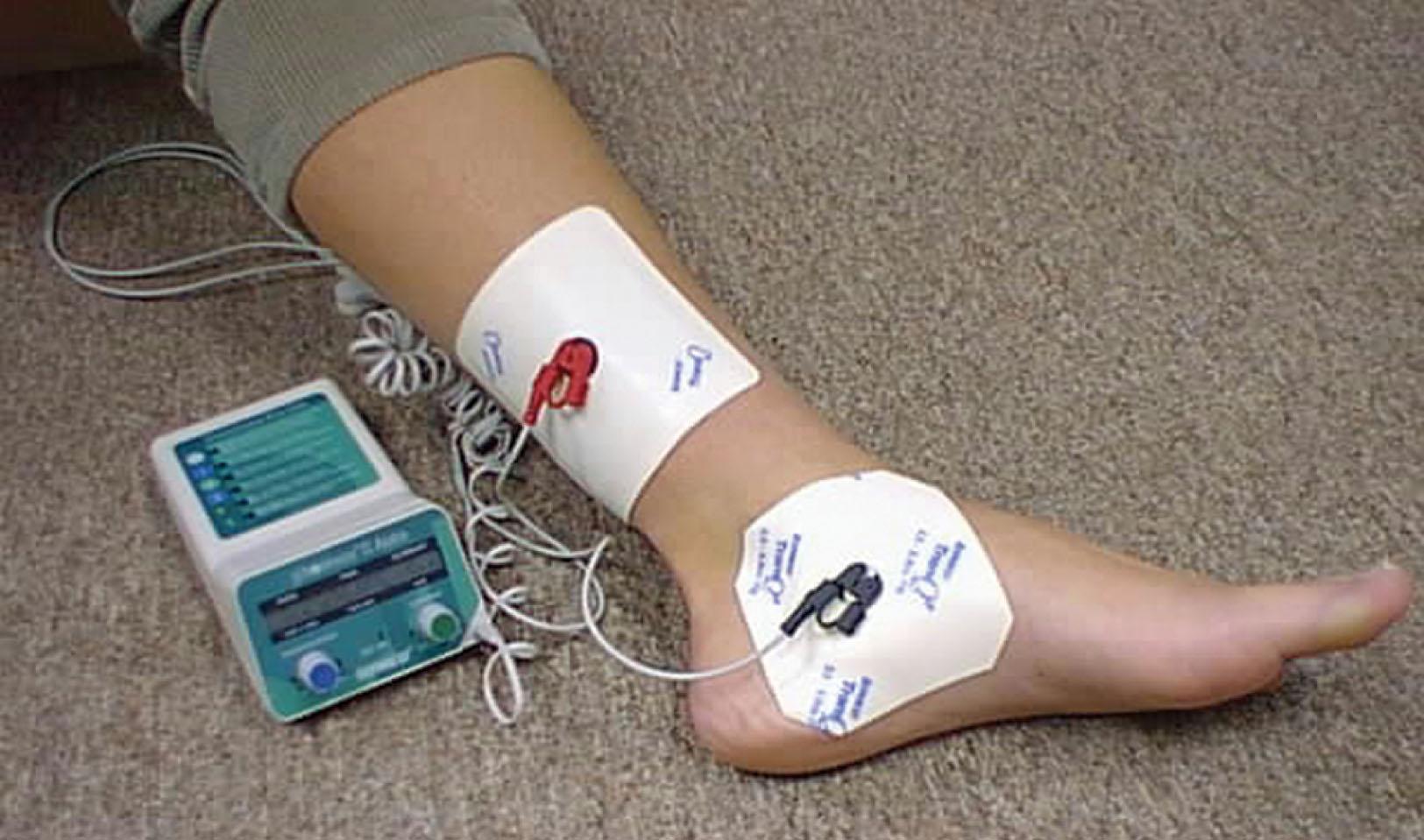
Isolated strengthening of the PTT should be avoided until the above-mentioned treatment protocol eliminates the patient's pain. Aggressive strengthening used while the tendon remains painful will only exacerbate the symptoms and lengthen recovery.
Therapeutic strengthening must be focused on adduction to maximize effectiveness. Selective activation of the PTT was explored by Kulig et al. The authors used MRI to evaluate changes in muscle activation during exercise. They found the greatest increase in posterior tibial muscle activation occurred with resisted foot adduction by using resistance bands (Thera-Band) (activation increased 50%) compared with the surrounding musculature (average increase, 5%). Heel rise and resisted forefoot supination produced less than half of the activation of the posterior tibial muscle when compared with foot adduction. Anatomically, the perpendicular course of the PTT relative to the oblique midtarsal joint axis allows contraction of the muscle belly to adduct at the oblique midtarsal axis.
Such therapeutic strengthening, along with stretching the gastrocsoleus complex, has shown proven benefit. The authors, Kulig et al, studied patients with PTT pain (both by palpation and ambulation) that lasted at least 3 months, combined with weakened single–toe-rise testing. Using validated tests, such as the Foot Function Index and Visual Analogue Scale (VAS), the authors assessed the ability of both eccentric posterior tibialis exercised and gastrocsoleus stretching (with knee both extended and flexed) to relieve pain and improve function. It should be noted that an additional variable was introduced by asking the participants to wear orthotics for 90% of their waking hours. The authors added to their evaluation armamentarium by performing gray-scale ultrasonography and Doppler image acquisition to diagnose tendon abnormalities both before and after intervention. Although the studies lasted 6 months, it was noted that by 10 weeks posttreatment a significant improvement in symptoms (pain relief, function, and strength) allowed the patients to return to normal activities. However, this protocol did not change the character of the PTT with respect to neovascularization (a measure of inflammation) or morphology. Thus, it remains to be seen whether symptoms recurred after the cessation of this research protocol because the authors did not study the population beyond 6 months.
Orthotic and brace management has been a large focus of attention in conservative management of PCFD. Simply put, attempts to lessen strain across the PTT may be instituted by elevating the medial arch and eliminating pronation. Before instituting orthotic management, it is important for the clinician to determine if the deformity is fixed or flexible because the orthotist will benefit from specific instructions in fitting this device, and patient satisfaction hinges on appropriate construction. When the patient has a flexible deformity, the heel must be in a subtalar neutral position when the orthotist makes the mold for the orthosis. In this case, the orthosis will have true corrective power, lessening the stress applied to the PTT. If the deformity is rigid, the orthosis is molded in situ, without attempts at correction. In this situation, comfort and pain relief will be enhanced by not attempting to correct an uncorrectable foot.
Patients with milder deformities can achieve success with a semirigid orthosis with a medial heel wedge and a medial column post. This may be particularly effective in tendinitis or tendinosis of the tibialis posterior tendon ( Fig. 29-16 ). However, as the patient has increasing deformity, with the deformity remaining flexible, a total-contact rigid orthosis or a University of California Biomechanics Laboratory (UCBL) brace may become necessary ( Fig. 29-17 ). The UCBL brace has been shown to significantly affect the orientation and movement of the subtalar joint (and the ankle and knee joints) by reducing the degree and duration of abnormal pronation during the stance phase of gait. The biomechanical principle of the UCBL is to stabilize the heel in neutral and prevent abduction of the forefoot. Abduction is blocked by building up the lateral border of the foot piece. This maneuver helps to reestablish the longitudinal arch.
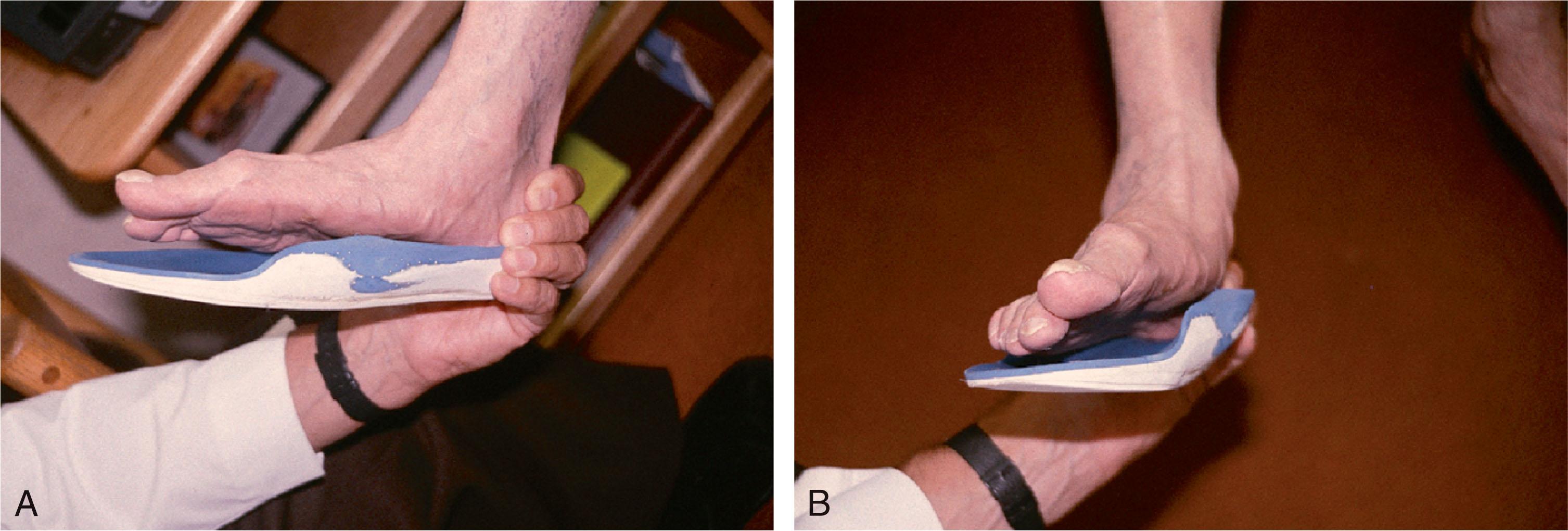

Chao et al used the UCBL with medial posting in patients with flexible deformities defined as less than 10 degrees of residual forefoot varus in a subtalar neutral position. Those with rigid deformities were treated with a molded solid-ankle ankle–foot orthosis (AFO). This study did not specifically look at the effectiveness of the UCBL brace; rather, its purpose was to assess the success of brace management for PTT dysfunction. The authors found that 67% of patients achieved a good-to-excellent result with both braces (UCBL or AFO) as a nonoperative adjunct to treating the condition.
Augustin et al evaluated the use of the Arizona brace, first introduced in 1988, in nonoperative management of PTT dysfunction ( Fig. 29-18 ). Unlike the UCBL, this device has no significant impact on stabilizing the hindfoot, but it can restore the arch and midfoot kinematics. Augustin studied 21 patients who had stage 1, 2, and 3 disease and wore the brace an average of 10 hours per day. All patients with stage 1 and 2 disease showed pain relief referable to the brace, and 60% of patients with stage 3 disease showed similar improvement. Overall, 90% demonstrated statistically significant improvement with the Arizona brace. This thorough study evaluated patients with three separate scoring systems: the American Orthopaedic Foot and Ankle Society (AOFAS) Hindfoot Score, the Foot Function Index, and the SF-36 Health Survey. With all three scoring systems, the Arizona brace demonstrated statistically significant improvement in patient outcome.
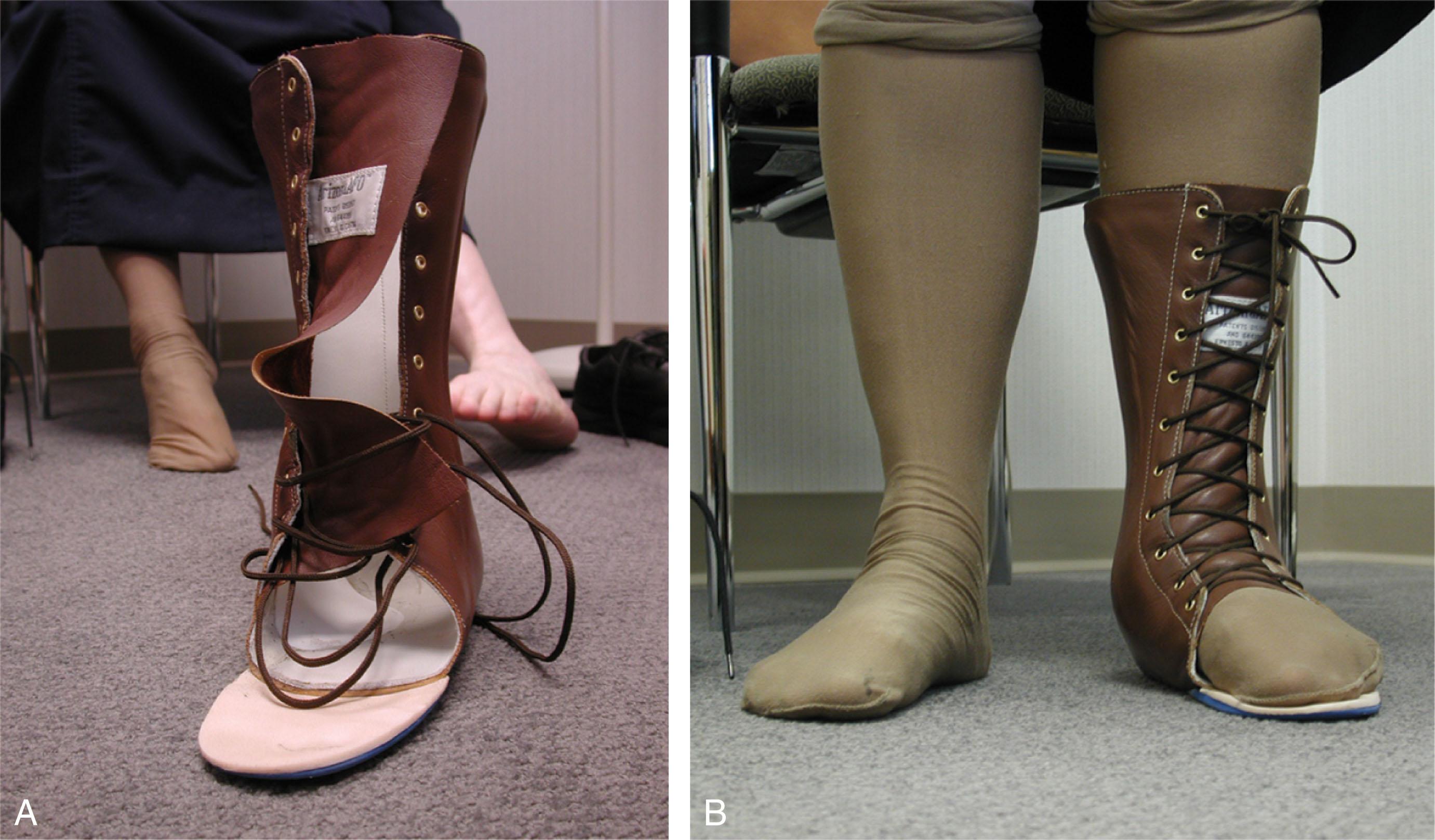
If patients progress to where the deformity is rigid and potentially arthritic, accommodation rather than correction becomes the primary function of the brace. The orthosis or brace is not molded in subtalar neutral. A more supportive device for both the ankle and the foot, such as a thermoplastic solid-ankle AFO, may be required for pain relief ( Fig. 29-19 ). A variety of additional braces, such as the Marzano articulated ankle brace, have been attempted with success in cases of more advanced deformity. Patients with arthritic ankle symptoms require a nonarticulated brace for comfort, such as a solid-ankle AFO. Care must be taken to avoid pressure over bony prominences in patients with more severe valgus deformities. Attempting to correct such a deformity by molding the AFO to negate ankle valgus can place undue pressure across the lateral malleolus, hindfoot, or fifth metatarsal base, causing pain or ulceration.
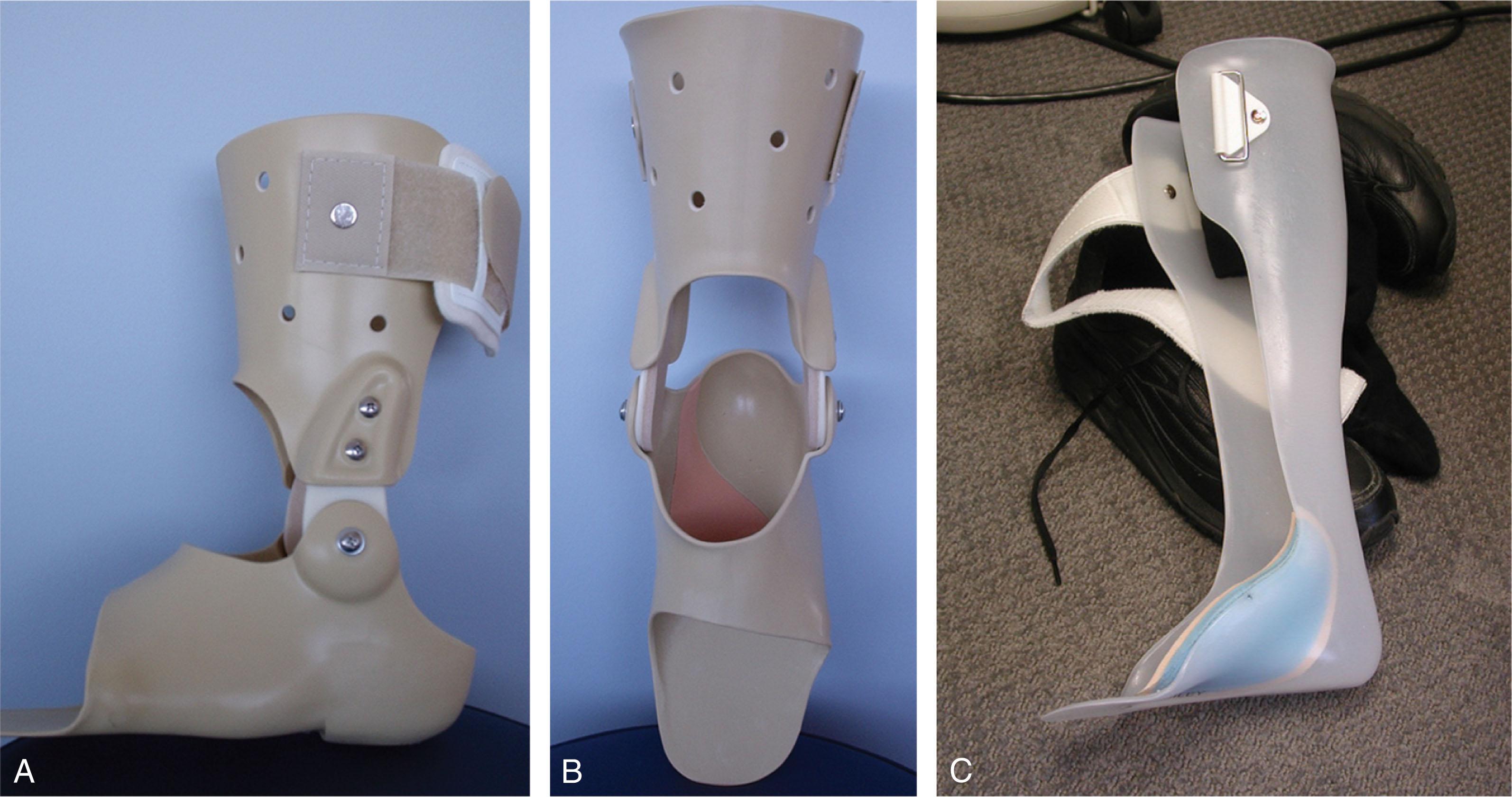
The effectiveness of an AFO in controlling forefoot abduction has been questioned by Neville and Lemley. These authors studied the ability of a custom AFO (both solid and articulated), an over-the-counter AFO, and a regular shoe (as a control device) to correct a variety of foot postures adopted in stage 2 PTT dysfunction. Throughout the gait cycle, all three devices were found to be no better than the control shoe in correcting forefoot abduction. Hindfoot inversion was only controlled significantly with the articulated AFO. This study led to concern that advanced bracing technologies were not correcting all planes of deformity and, as such, could lead to failure in treatment or progression of the disorder. This finding is supported by additional data in the literature.
Footwear modifications can enhance conservative treatment by stabilizing the foot, that is, by limiting pronation and strain on the PTT. Measuring the offset heel area can be done with the patient standing in the shoes to be modified, with equal weight placed on both feet. A straight ruler drops from the medial malleolus to the floor (perpendicular to the floor). This line forms a triangle with a second line drawn to the base of the shoe and a third line drawn from the base of the shoe to the malleolus. This triangle is the offset heel area, which is filled in on the shoe to establish stabilization of the longitudinal arch. According to Streb and Marzano, this offset should be approximately two thirds of the height of the medial shoe quarter. In addition, the offset can be made more effective by adding -inch to -inch additional medial post. Other footwear modifications include flanged heels, extended Thomas heels, and posting the medial heel and sole of the shoe from inch to inch to create support from heel to toe.
Often overlooked in the athlete with PTT dysfunction is the ability of appropriate shoe management to limit pain and lessen recurrence of tenosynovitis. According to Conti, athletes should wear a running shoe with a flared heel and not run more than 400 miles on any one pair of shoes. Midfoot cushioning significantly dissipates after 400 miles, resulting in less arch support, less ability to control pronation, and increased tension on the PTT.
Combining orthotic management with a concentrated, aggressive exercise program has support in lessening symptoms of PTT dysfunction, as noted by Alvarez et al. The authors evaluated 47 consecutive patients with stage 1 or 2 PTT dysfunction. No advanced diagnostic imaging was used in this study to quantify tendon disease. An above-ankle articulated device (70%) or orthotic (30%) was used in combination with a high-repetition strengthening and stretching therapy and home program over a 4-month interval (median). The authors considered a successful outcome to be 90% improvement in strength, manifested as the ability to perform 50 single-limb rises without pain and ambulate 100 feet on toes, among other criteria. Their methods demonstrated statistical significance with respect to said strength, and 89% were satisfied after the conclusion of treatment (although only 83% had successful subjective and objective outcomes).
Some authors have suggested that conservative treatment has a limited role in PTT dysfunction because it gives no relief and can allow the condition to worsen. However, most authors agree that unless a severe structural deformity is present, a 3- to 6-month trial of conservative management is indicated for PTT dysfunction. The treating physician must pay careful attention to the patient, however, to look for signs of progressive deformity. The only circumstance that can cause the clinician to consider operative intervention sooner is in patients afflicted with seronegative spondyloarthropathy and PTT tenosynovitis. Myerson et al suggest that failure of conservative care over a 6-week period should prompt surgical tenosynovectomy to prevent potential tendon rupture.
Patients with tibialis posterior tenosynovitis in the absence of deformity are not classified in the new scheme of PCFD. They are, however, considered here as a traditional group that falls within this category. Although indications are defined for tenosynovectomy of the PTT, the procedure is often not necessary. Symptoms often resolve with conservative treatment. Still, in refractory cases, tenosynovectomy is indicated as an isolated procedure in patients with persistent inflammatory symptoms without perceptible deformity of the hindfoot. Timing of tenosynovectomy is influenced by the suspected cause of the condition. Patients with florid tenosynovitis resulting from conditions such as rheumatoid arthritis or the seronegative spondyloarthropathies benefit from tenosynovectomy after a 6-week trial of conservative care. In contrast, patients with more classic stage 1 disease—inflammation resulting from mechanical phenomena or more advanced age—can continue conservative care for up to 3 months before tenosynovectomy is considered.
Tendoscopic techniques for evaluating and treating early stage PTT tenosynovitis have been described as early as 1997. They hold promise for creating less soft tissue scarring and faster recovery, but are challenging to perform. It may be used alone to treat a variety of pathology or as a precursor to open procedures to address underlying pathology.
The main contraindication to performing an isolated tenosynovectomy is disease within the substance of the PTT. Patients with degenerative changes or intrasubstance rupture of the PTT require more advanced procedures. Static deformity apparent through clinical and radiographic examination also warrants more advanced procedures.
There is recent evidence that repair of the PTT without FDL tendon transfer is valid even under circumstances where the tendon demonstrates more significant splitting or tearing. High-level dancers require strong FDL tendon strength in their lesser toes to achieve demi-point, and thus sacrificing that tendon in transfer may compromise their career. As such, Deland and Hamilton successfully performed repair rather than sacrifice the PTT, allowing the dancer's toe return to 90% function under guarded circumstances. Career choice plays a part in operative decision making under select circumstances.
Direct palpation over the PTT medially elicits pain. The medial ankle might feel boggy or fluctuant over the PTT. Strength testing is normal, although repetitive single–heel rises can reproduce the patient's symptoms of pain. Clinical inspection reveals symmetric feet and ankles, without hindfoot valgus or forefoot abduction. When viewed from behind, however, there may be asymmetric posterior swelling of the medial ankle on the affected side. Radiographs are symmetric with the uninvolved side, although MRI reveals fluid within the tendon sheath on T2-weighted images and a possible longitudinal split tear within the tendon on T1-weighted images. No mucinous degeneration is visible within the substance of the tendon.
The technique is as follows.
The patient is placed in a supine position. The normal external rotation of the extremity provides adequate exposure of the medial aspect of the foot. If that is not the case, placing a rolled bump under the opposite hip provides excellent external rotation of the involved extremity.
A thigh tourniquet is suggested to improve visualization of the inflamed tenosynovium.
The incision is centered along the course of the PTT. The length of the incision is from the navicular insertion to approximately 4 cm proximal to the tip of the medial malleolus.
The tendon sheath is opened with a knife and incised with scissors. In patients with systemic conditions, there is often an effusion of fluid. Patients with degenerative disease causing PTT insufficiency do not have an effusion of fluid.
Synovitis is visible as reddish-brown friable tissue adherent to the lining of the tendon sheath as well as to the tendon itself. All such tissue must be removed ( Fig. 29-20 ).
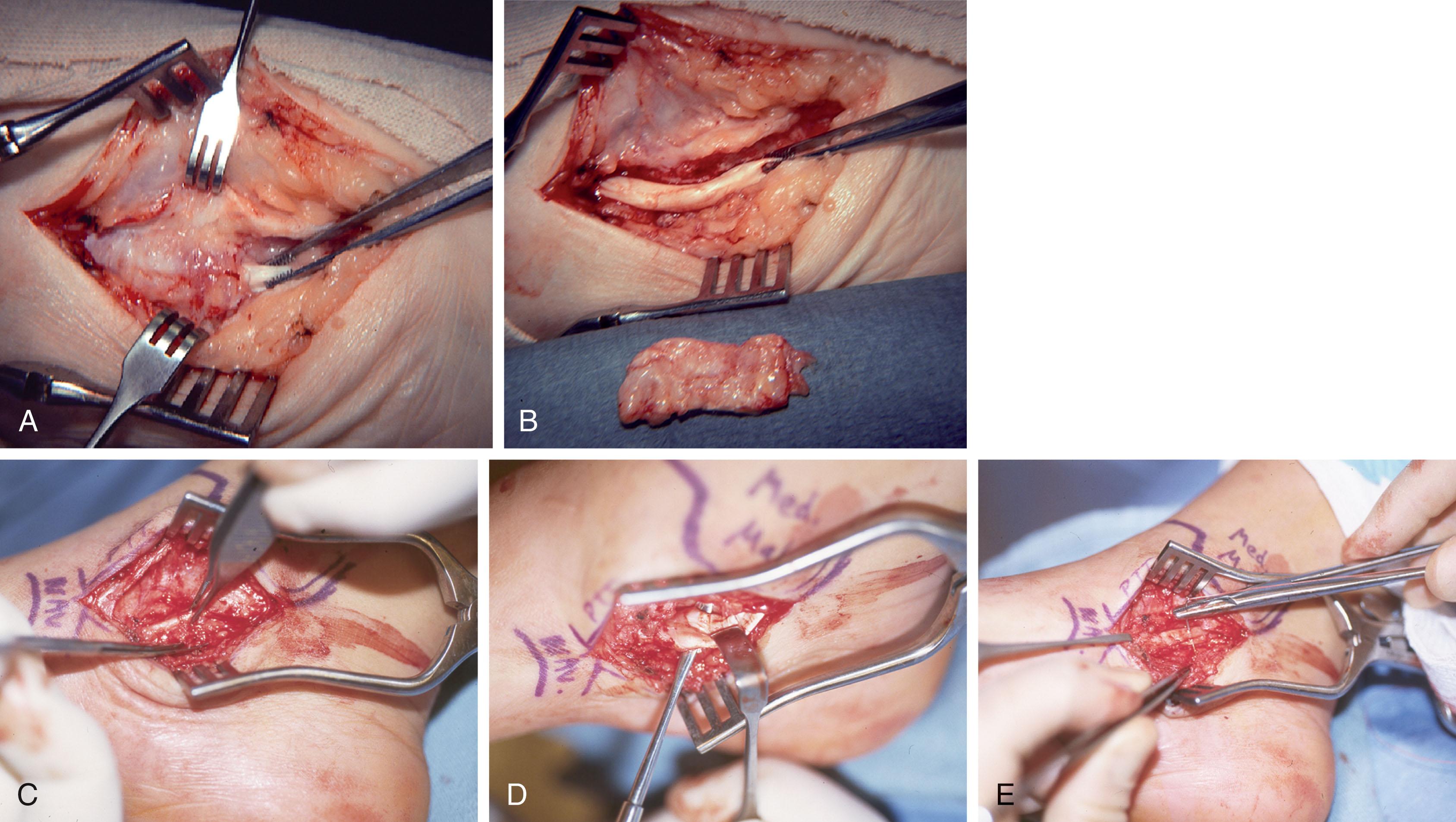
The tendon itself is carefully inspected. The surgeon evaluates the tendon for fusiform thickening and visible fissures. In particular, the surgeon must inspect the undersurface of the tendon because friction in this location often causes one or multiple split tears. If a fissure or split tear is noted, it should be repaired with a tubalization suture technique.
The surgeon must check the excursion of the tendon. As noted above, the normal excursion of the PTT is 1 to 2 cm. Excursion is easily detectable by marking the tendon at the apex of the medial malleolus and applying manual traction. A definitive number may be measured. If the tendon does not demonstrate this excursion, it is not a stage 1 deformity and therefore requires more aggressive intervention. The compliance (springiness) of the proximal musculature should also be assessed; stiffness may suggest more chronic disease requiring reconstruction.
With respect to disorders, the PTT should be inspected for avulsion from its insertion on the navicular. Although it may be tempting to simply repair the tendon directly to the navicular, often this is not feasible because of the limited excursion of the tendon and thus the higher failure rate after primary repair. In this instance, a FDL tendon transfer is performed, followed by a side-to-side tenodesis with the nascent PTT. This is the only instance where the native PTT may be preserved because the tendon itself has no intrasubstance disorders.
The sheath is then reapproximated in its entirety, preventing dislocation in the postoperative period. If a tourniquet was used, it is important to deflate it before closure to prevent copious scar tissue from compromising the result. The subcutaneous tissue and skin are closed, and the patient is placed in a sugar-tong plaster splint with a posterior mold or in a short-leg cast.
Become a Clinical Tree membership for Full access and enjoy Unlimited articles
If you are a member. Log in here